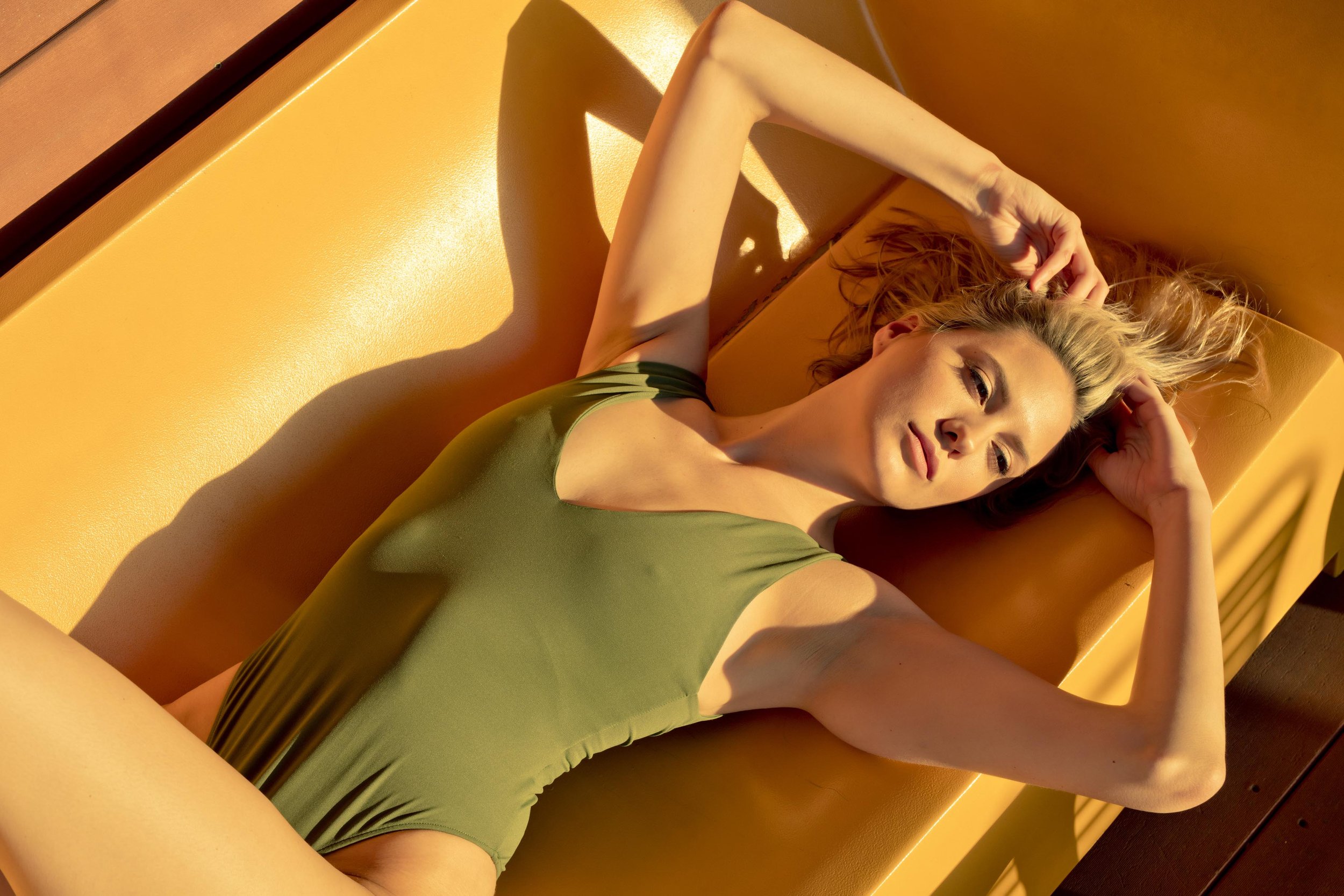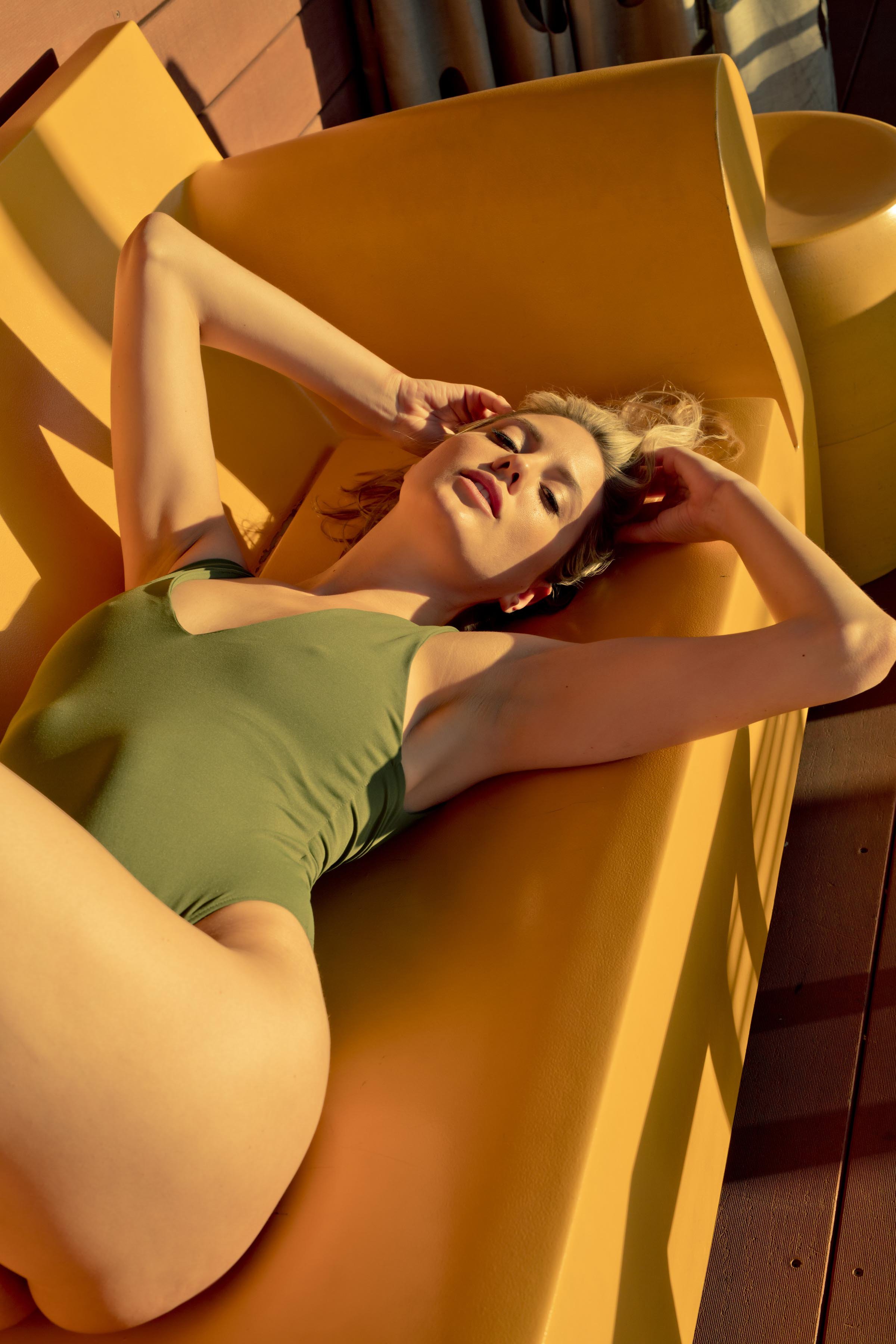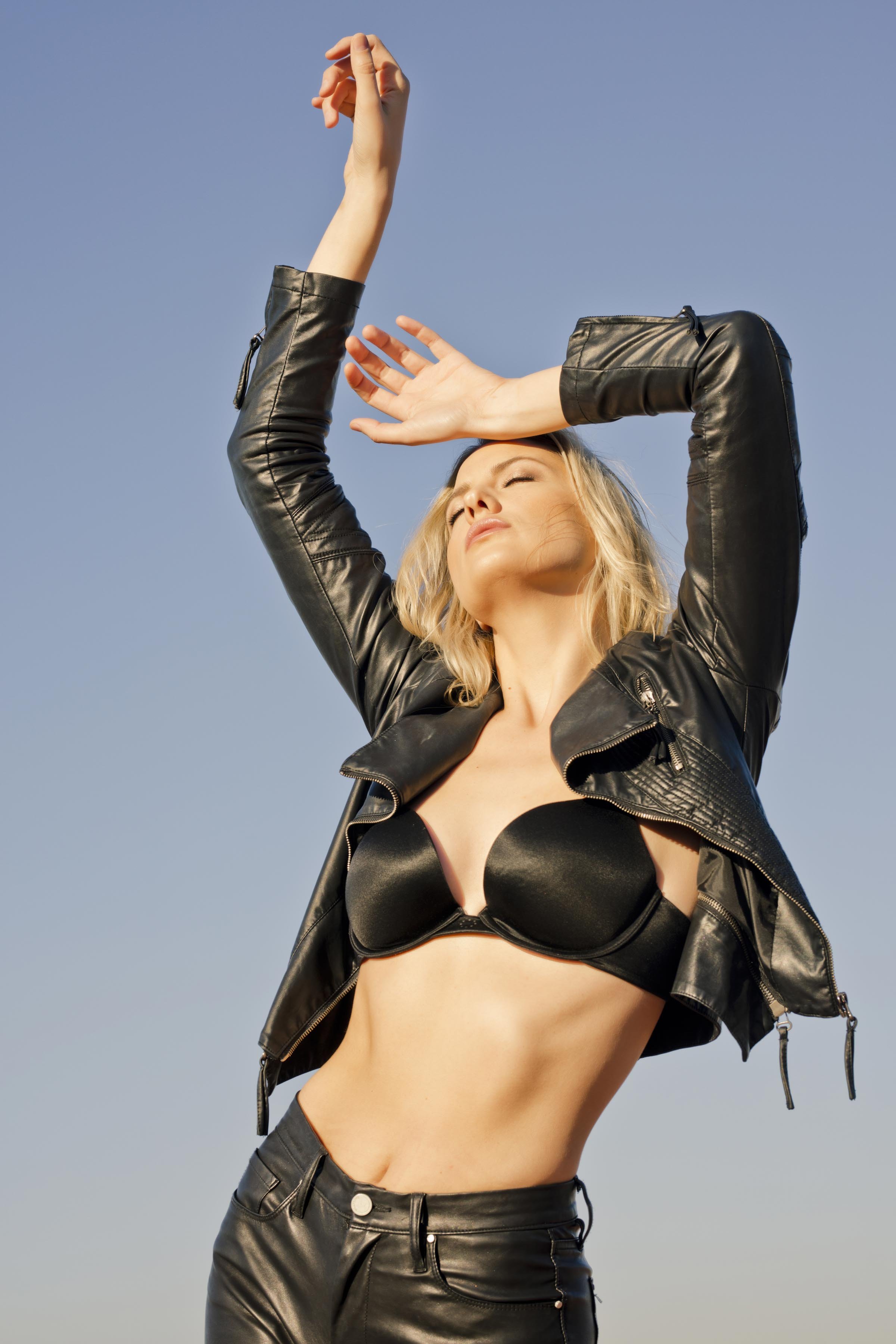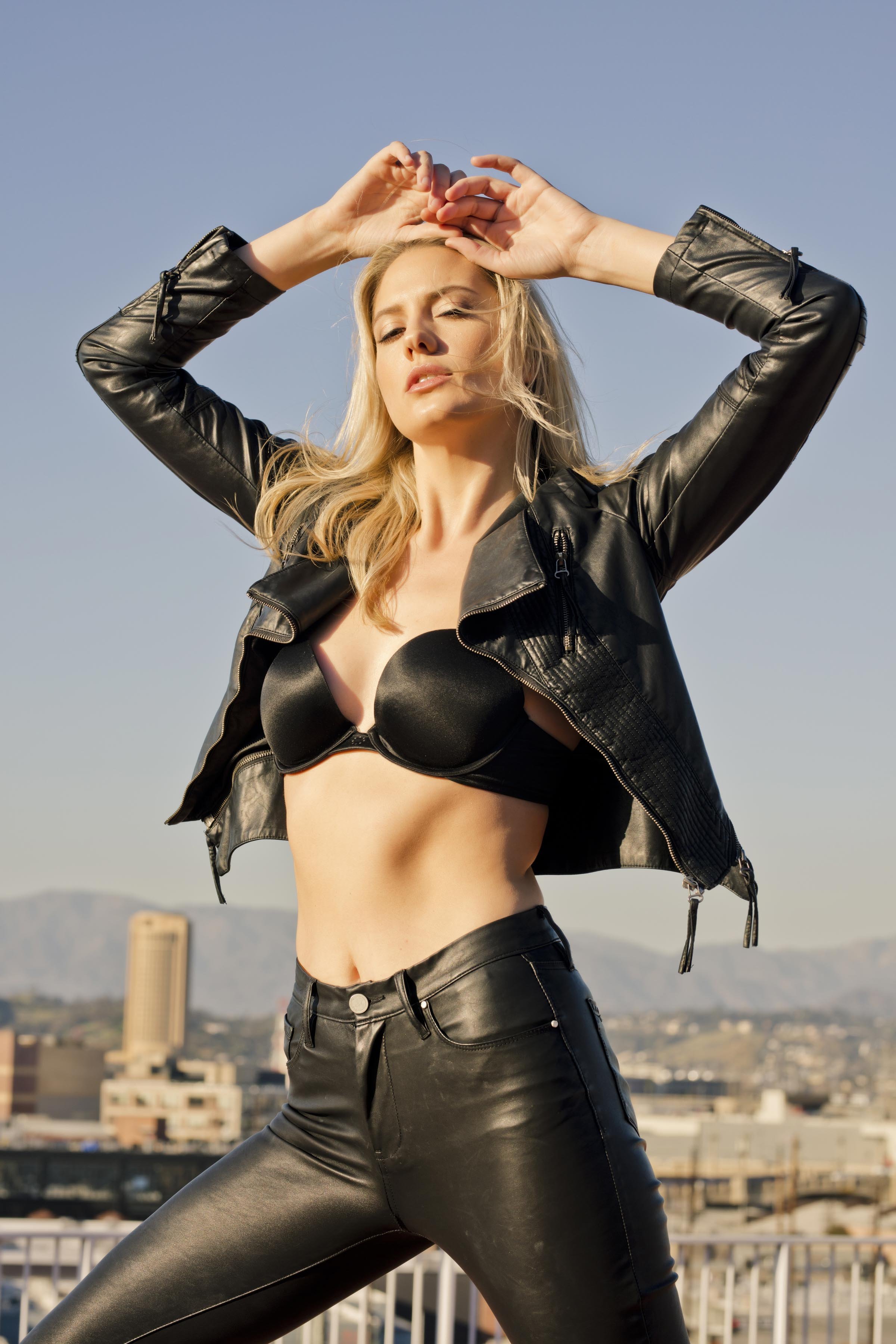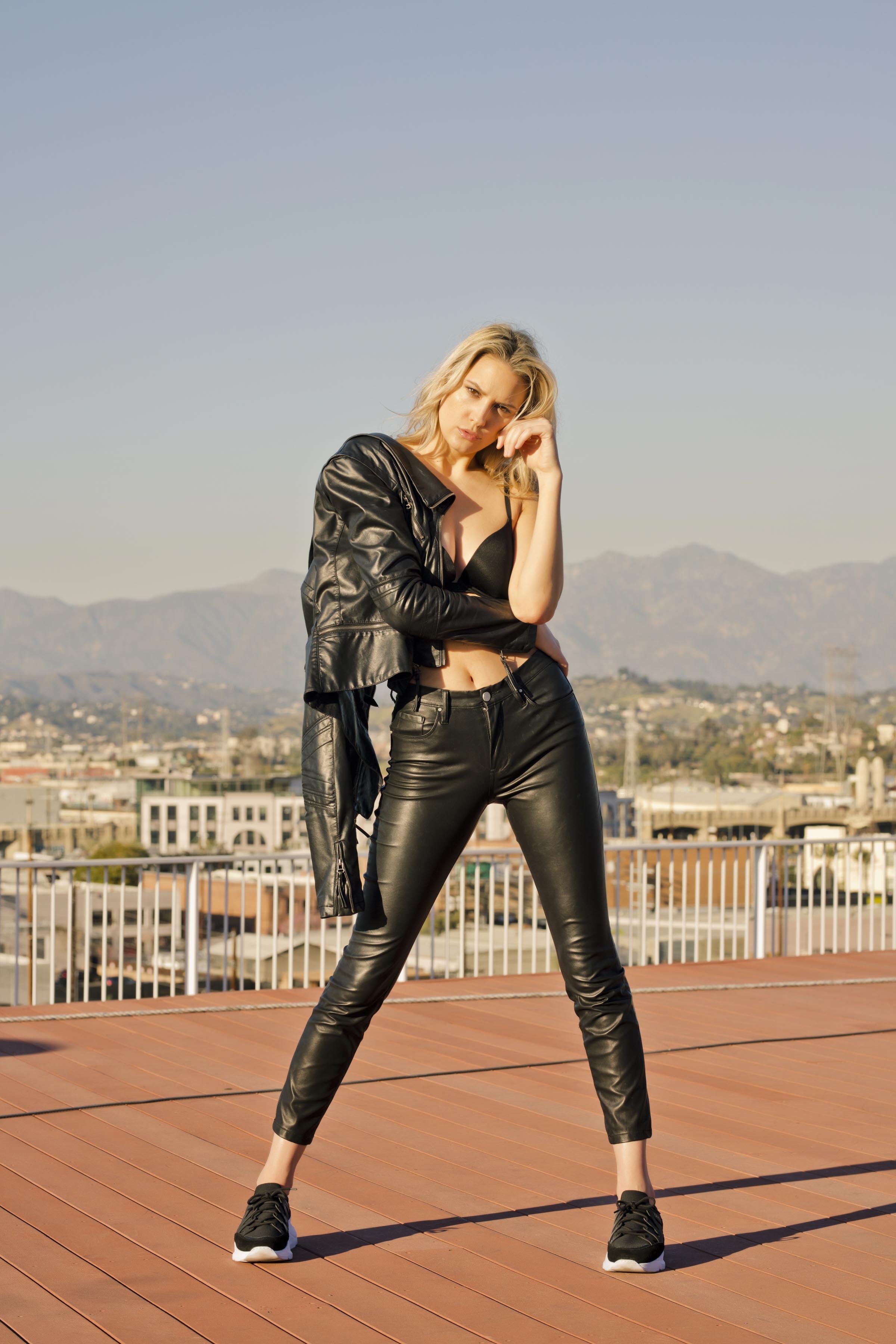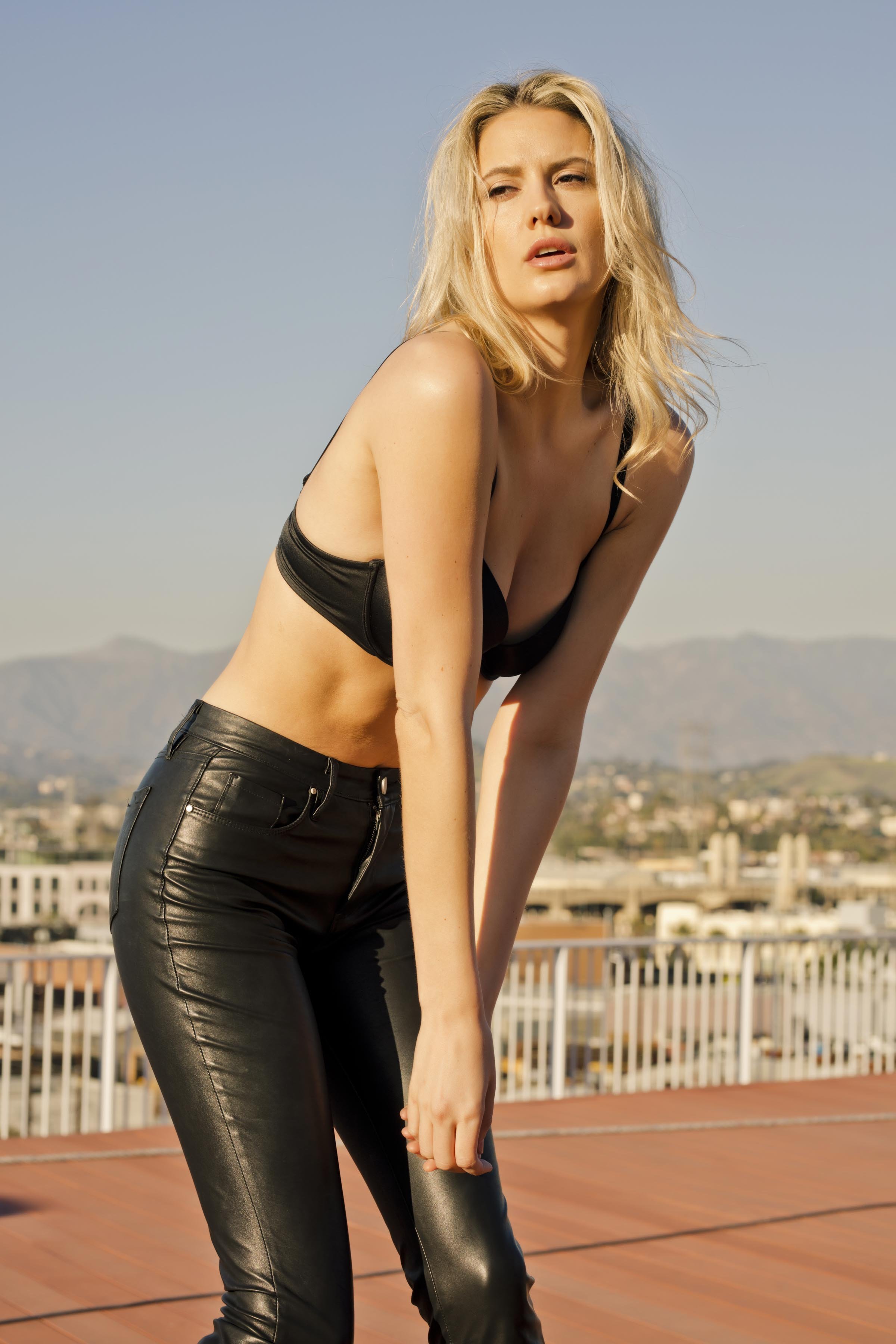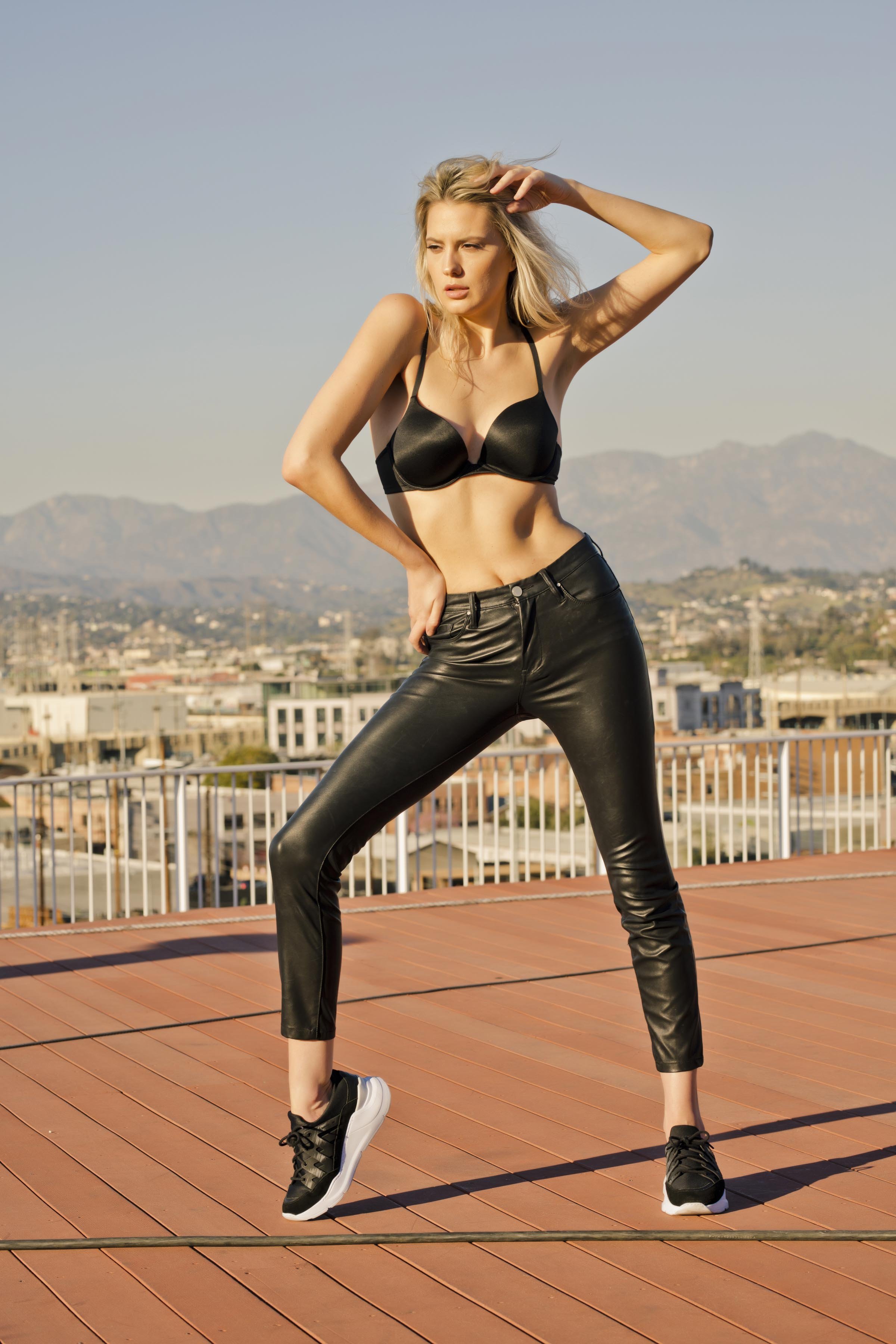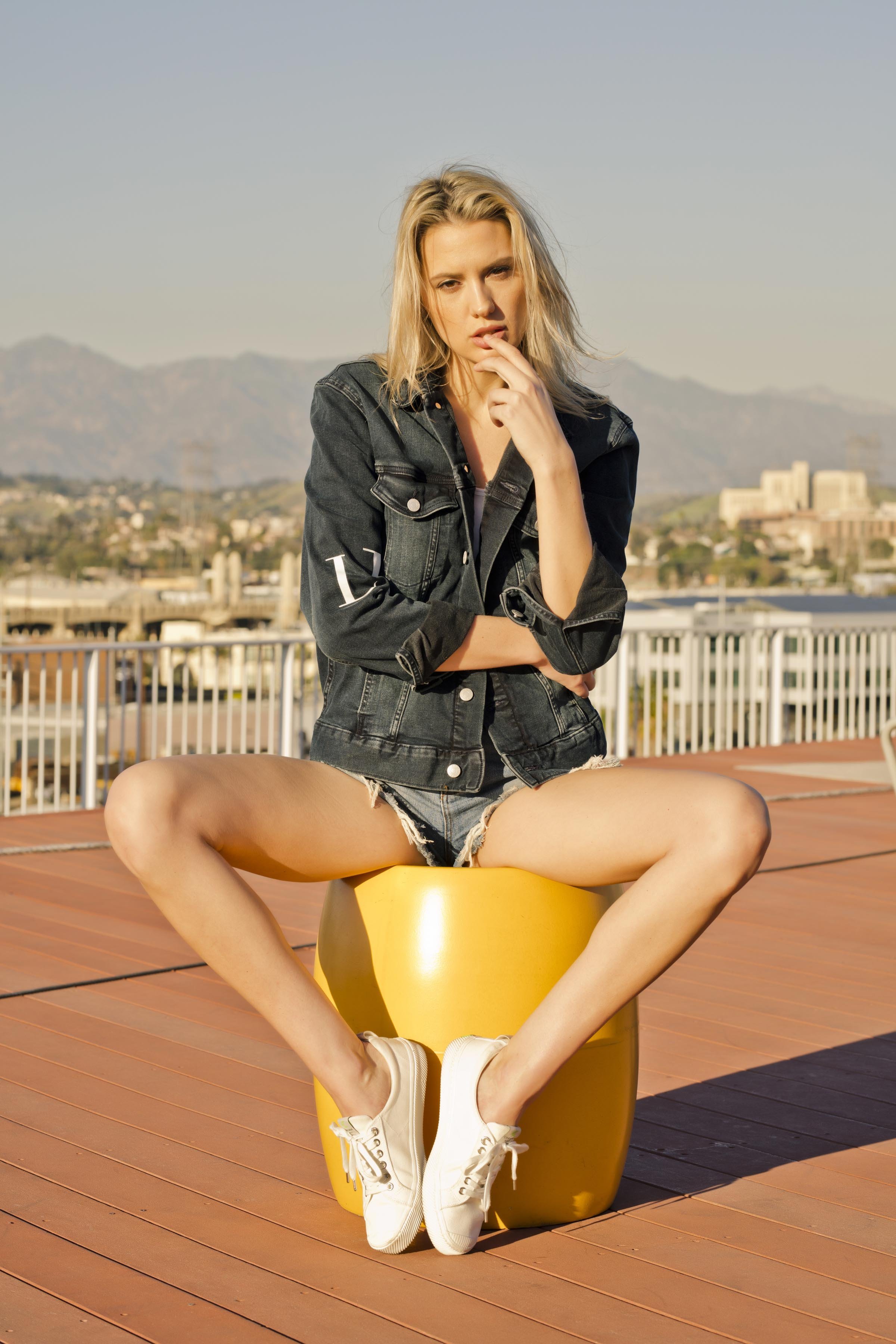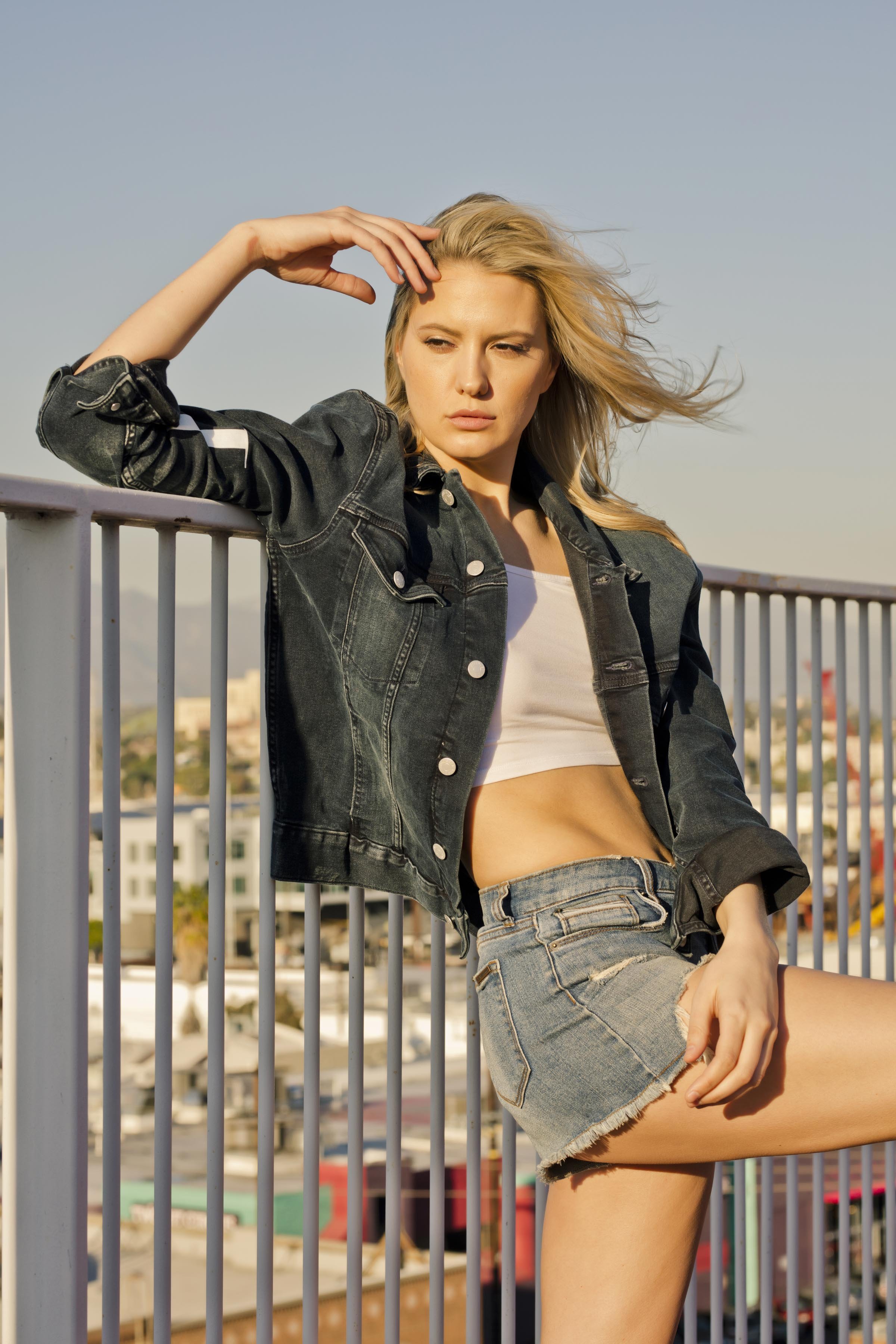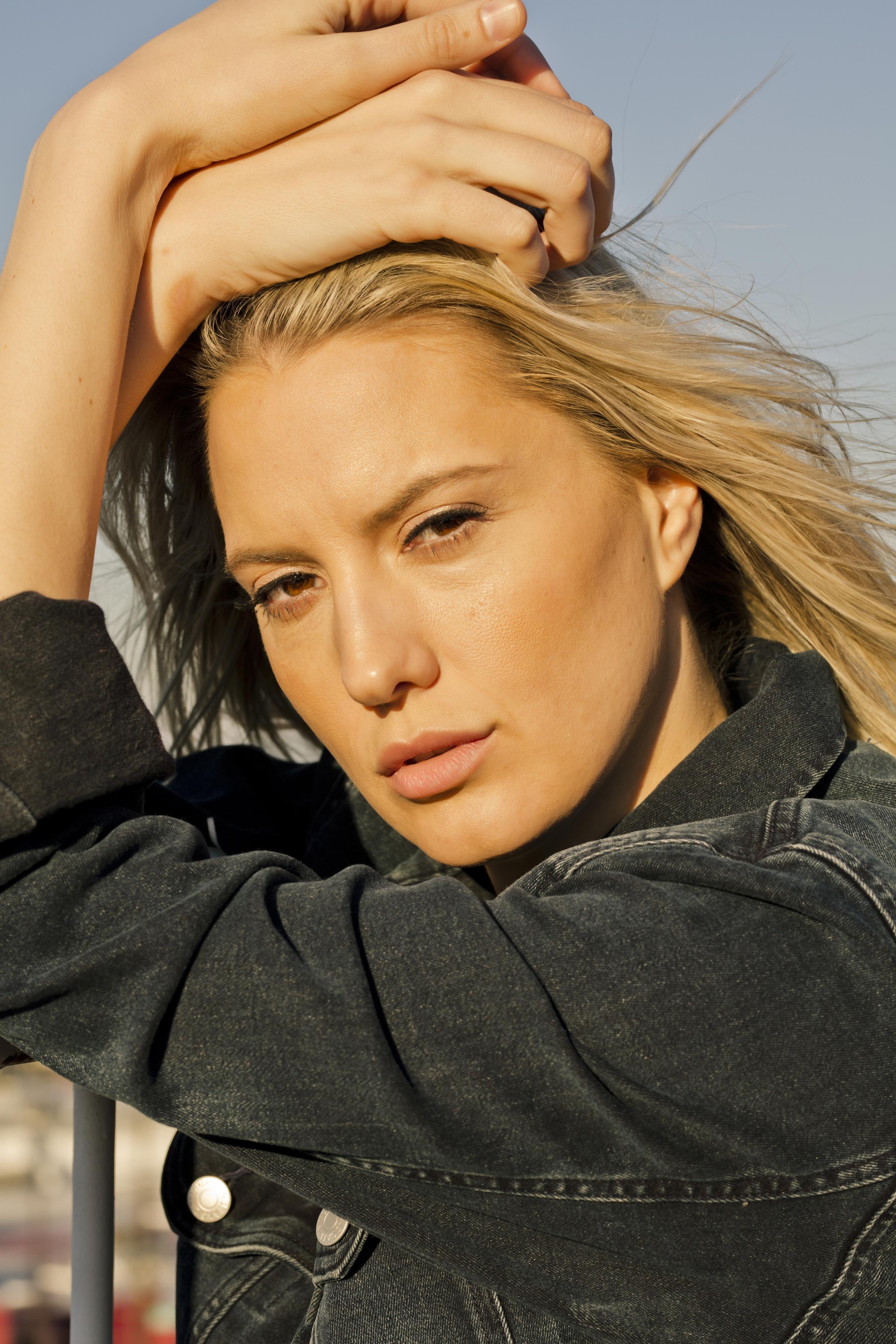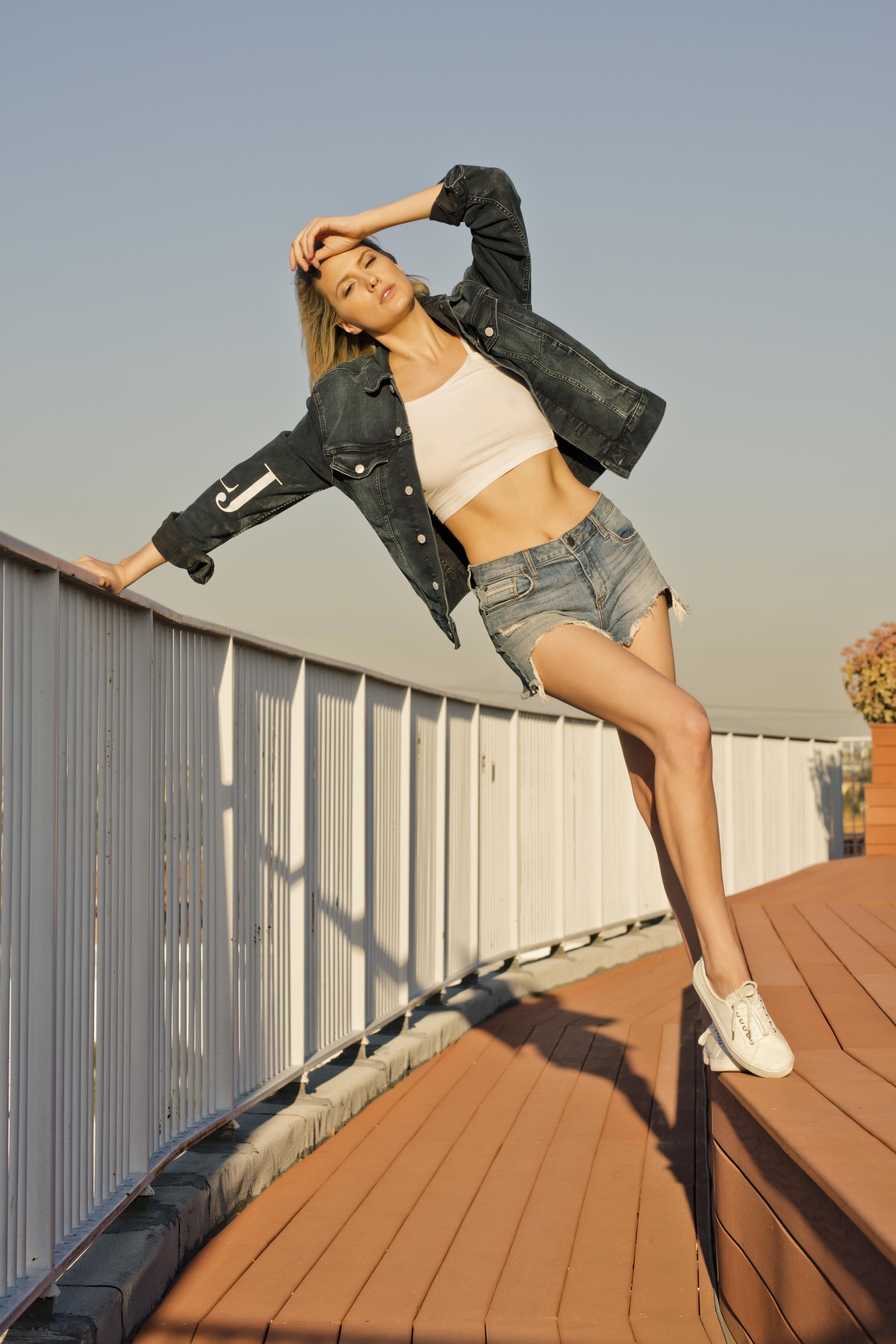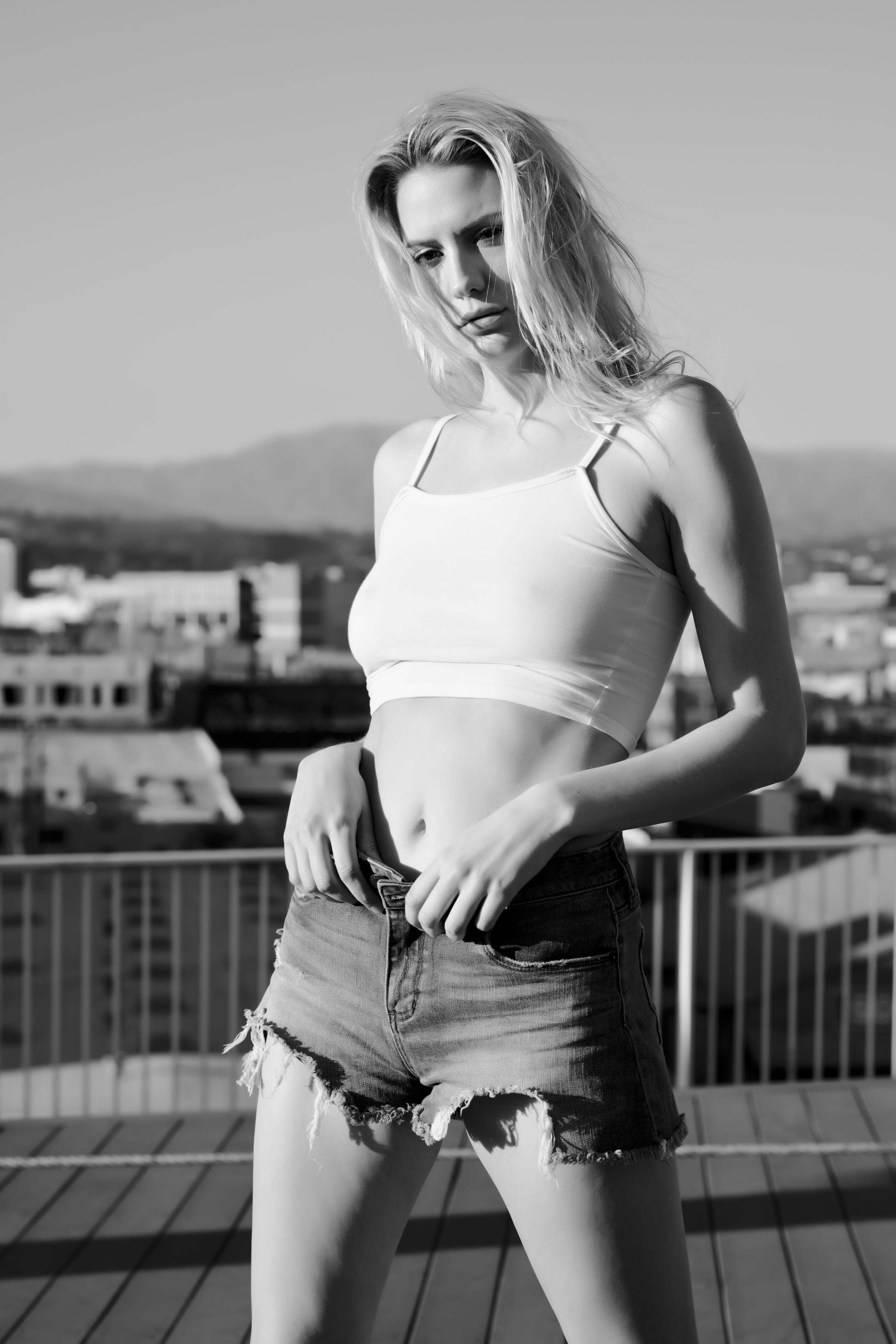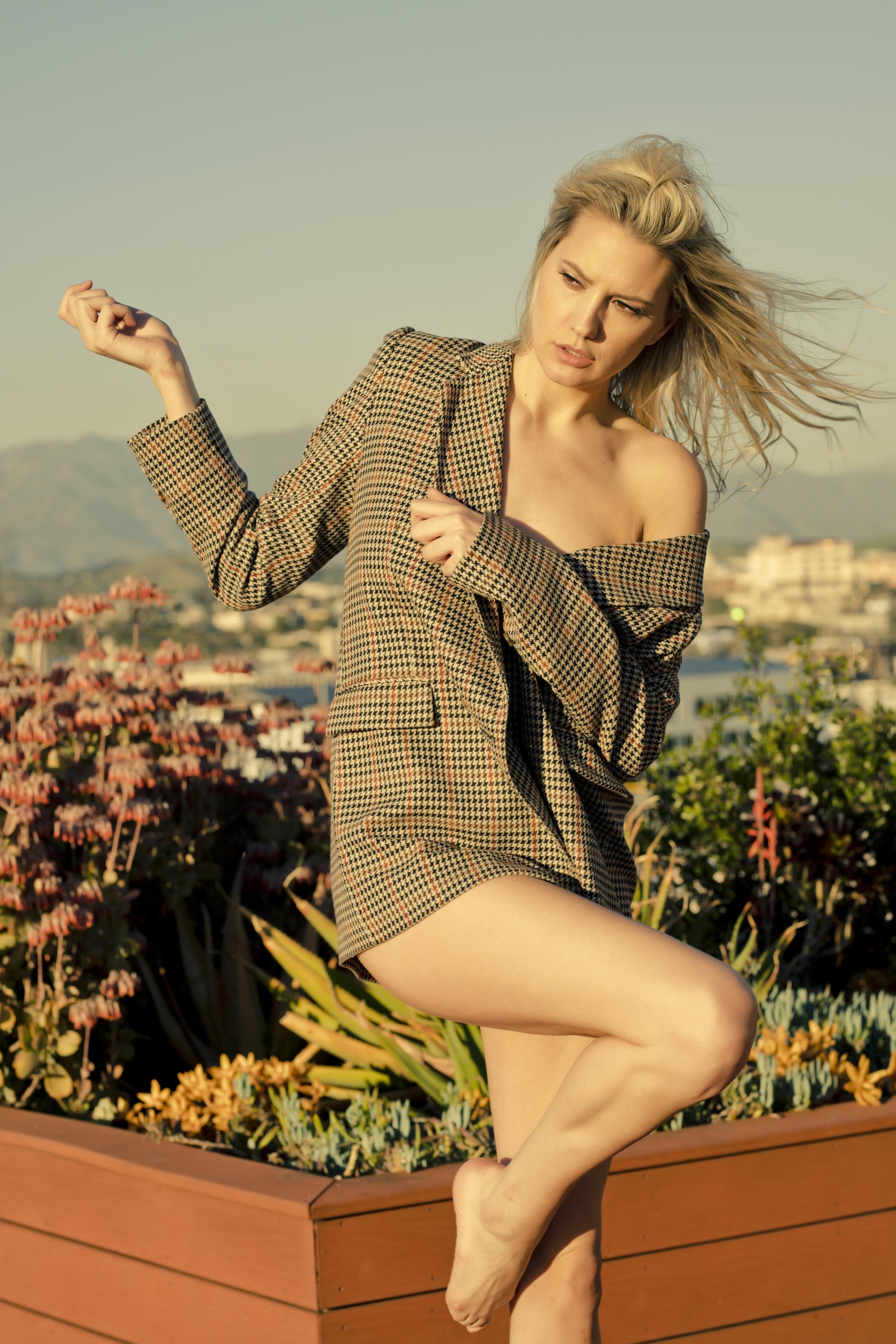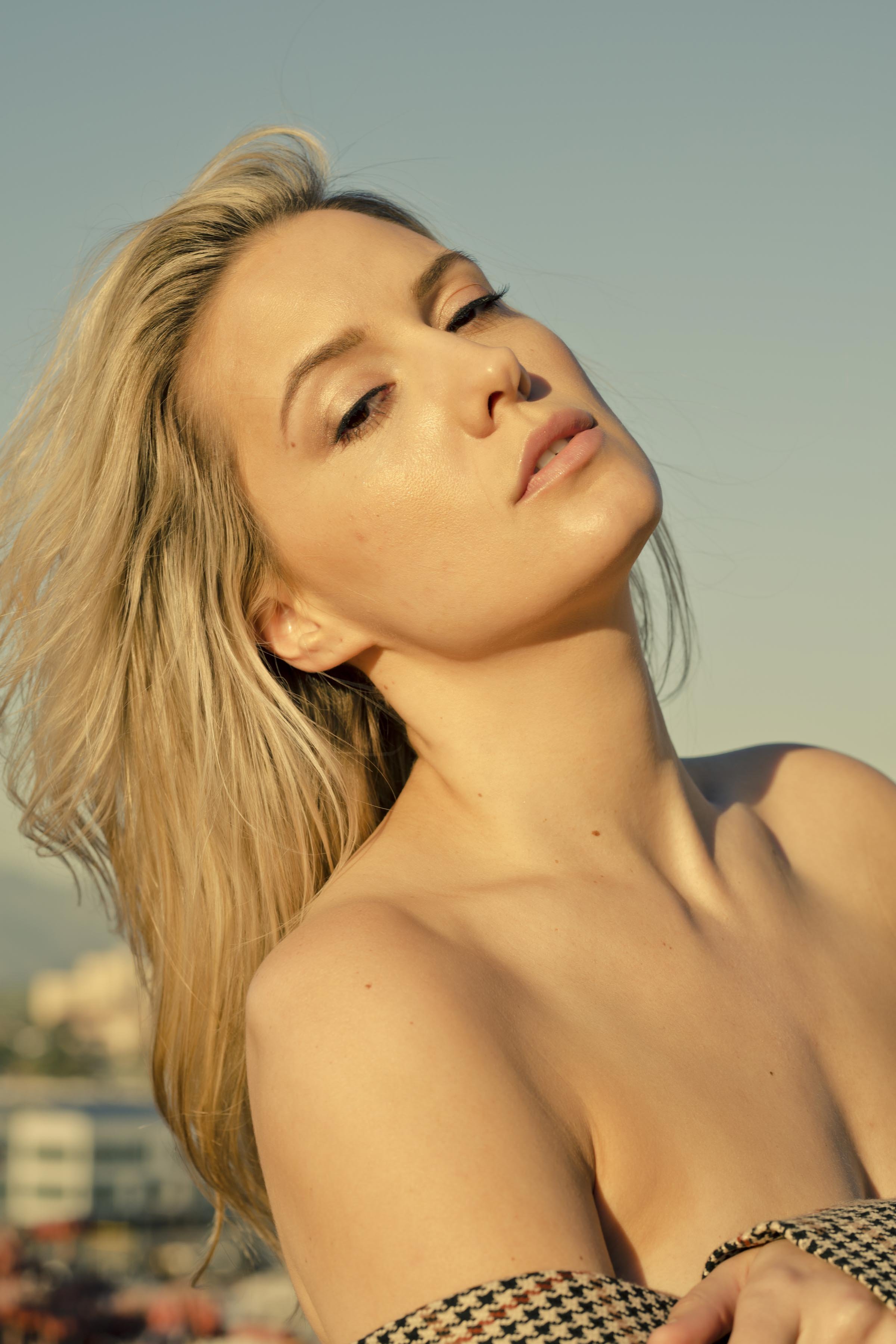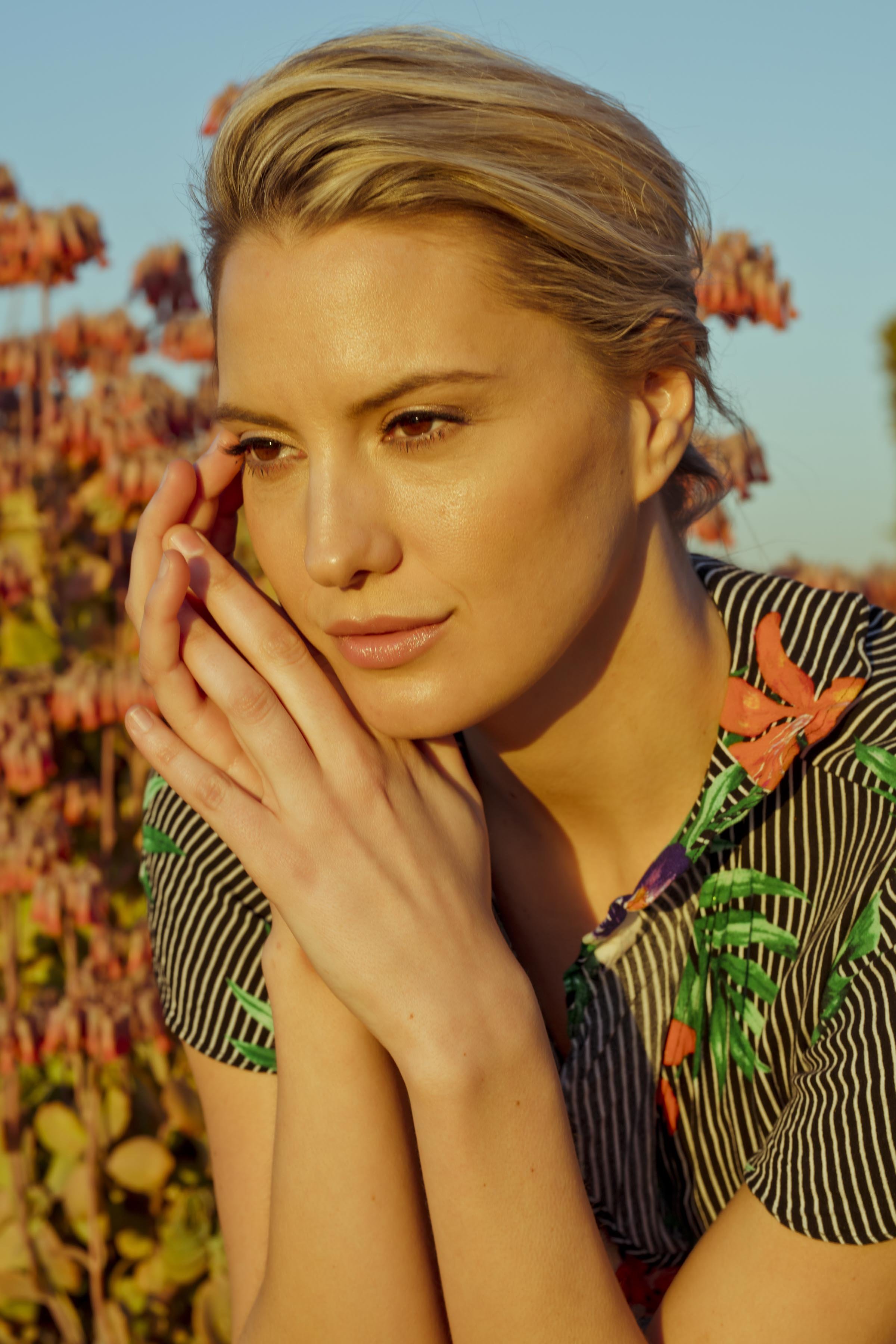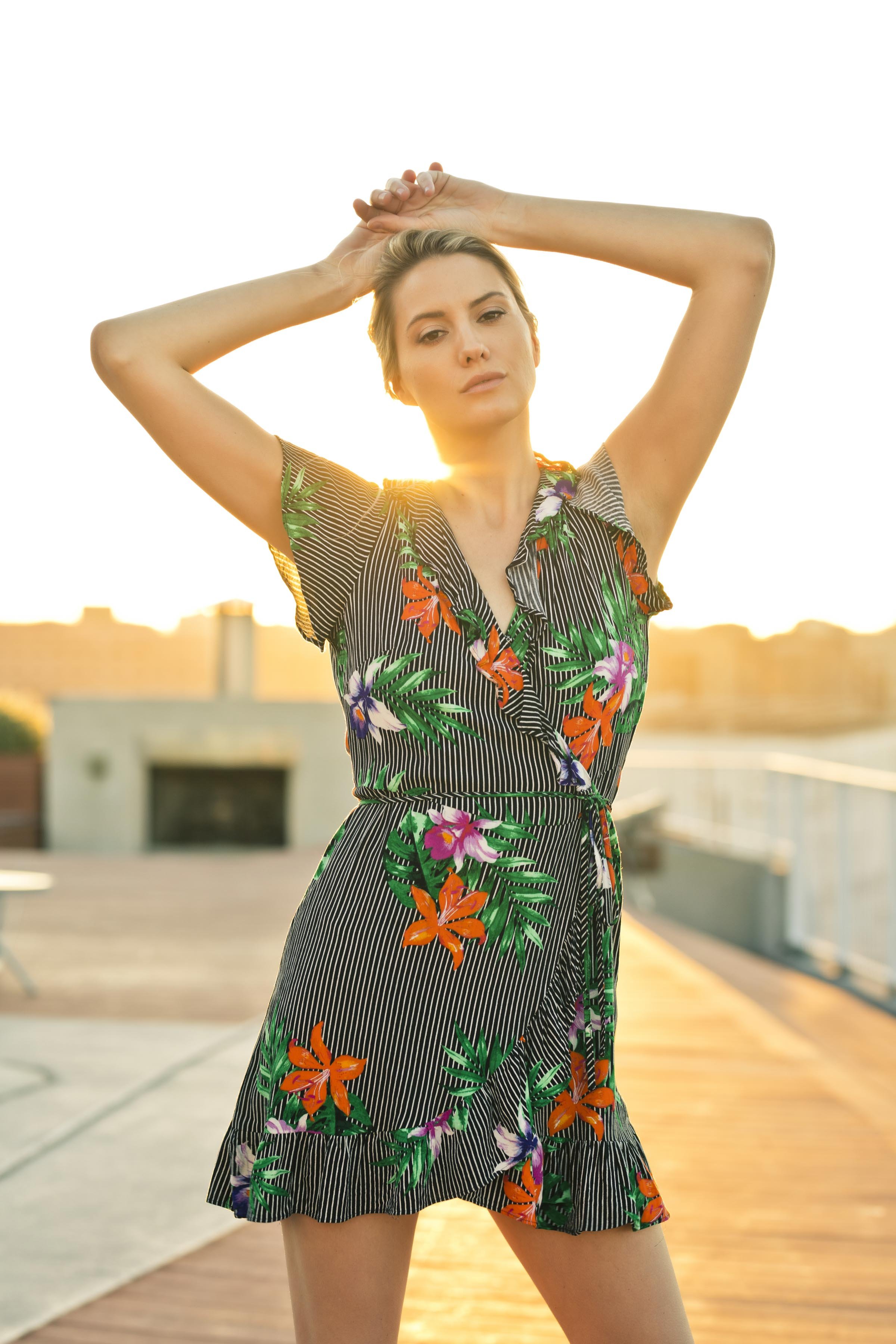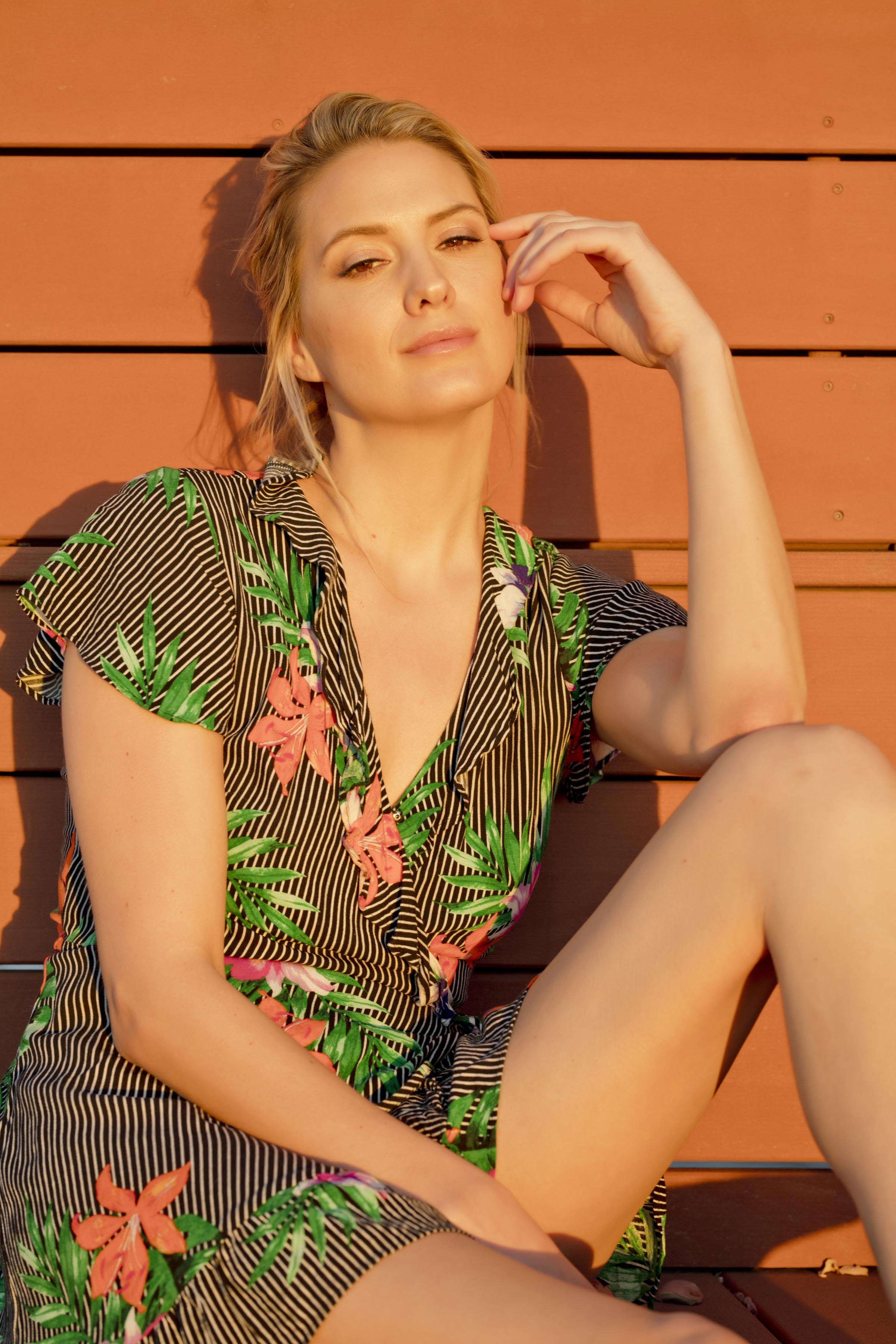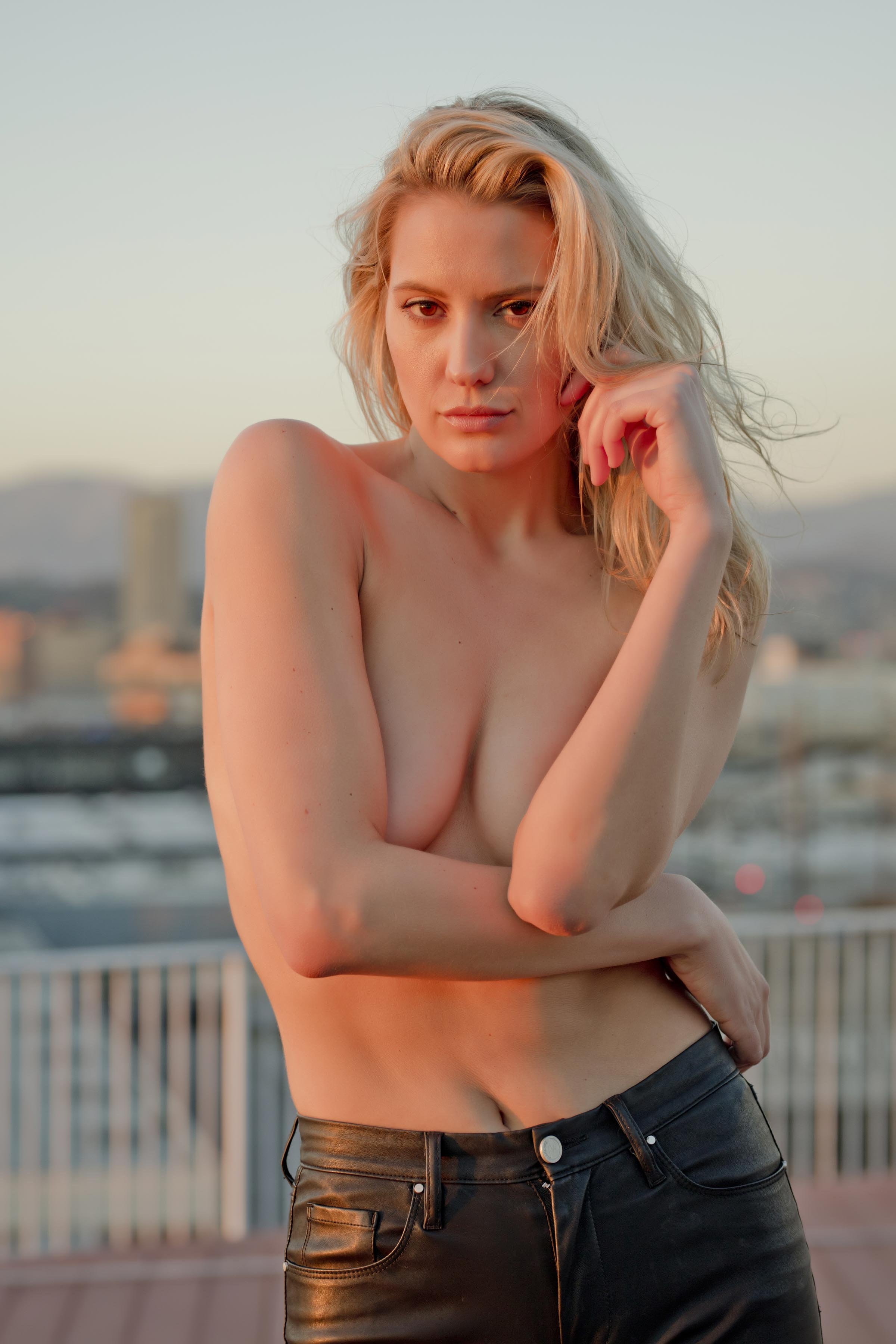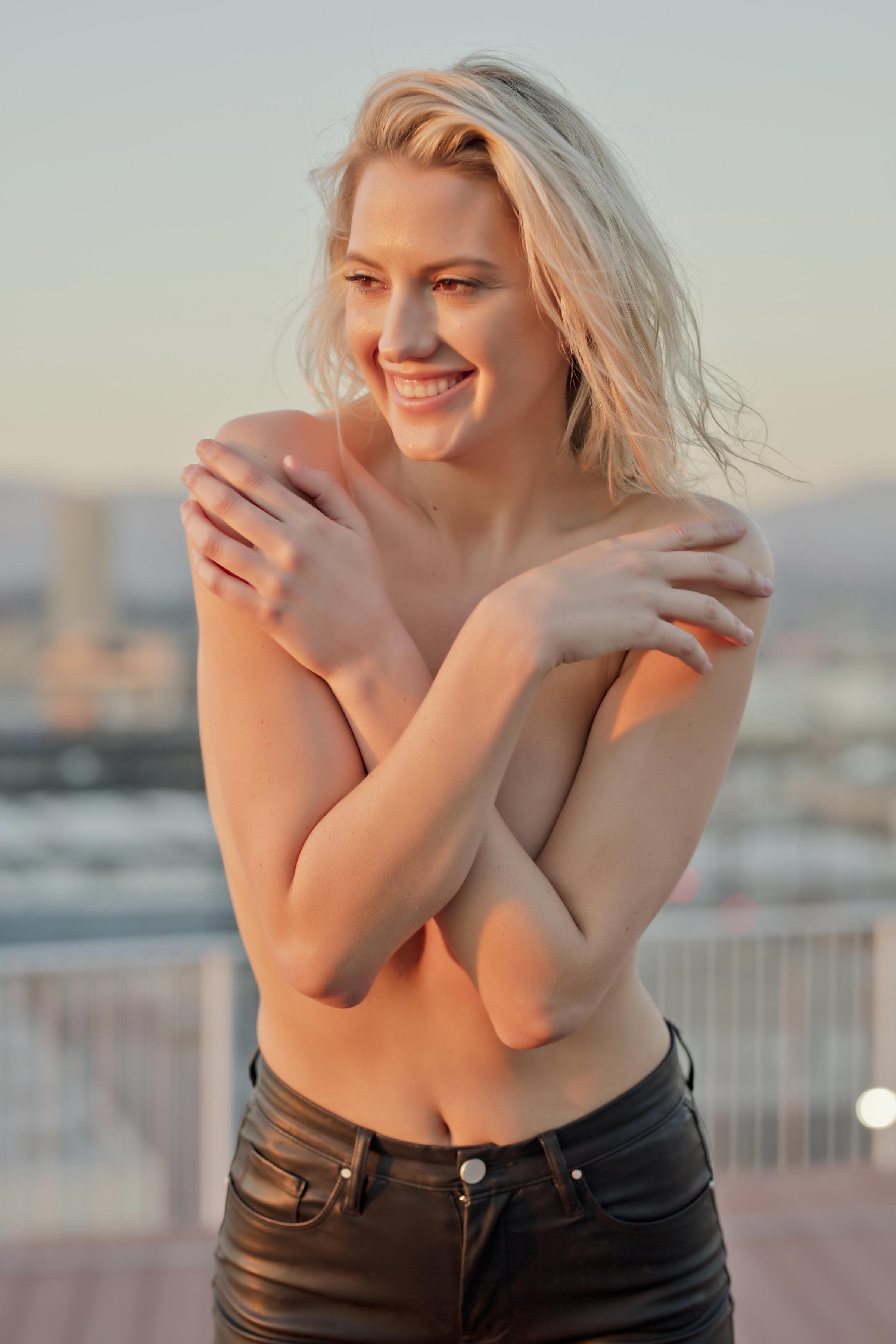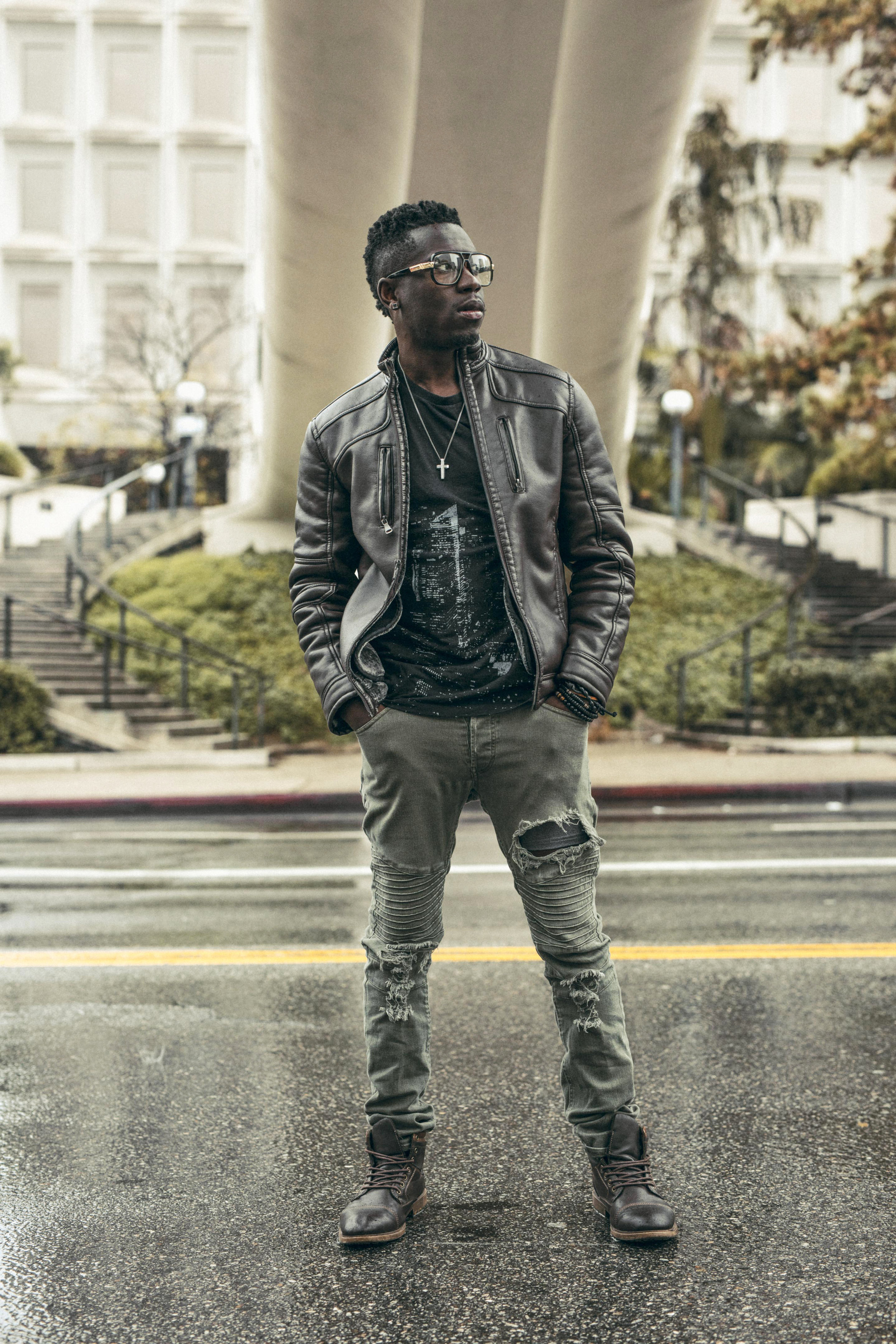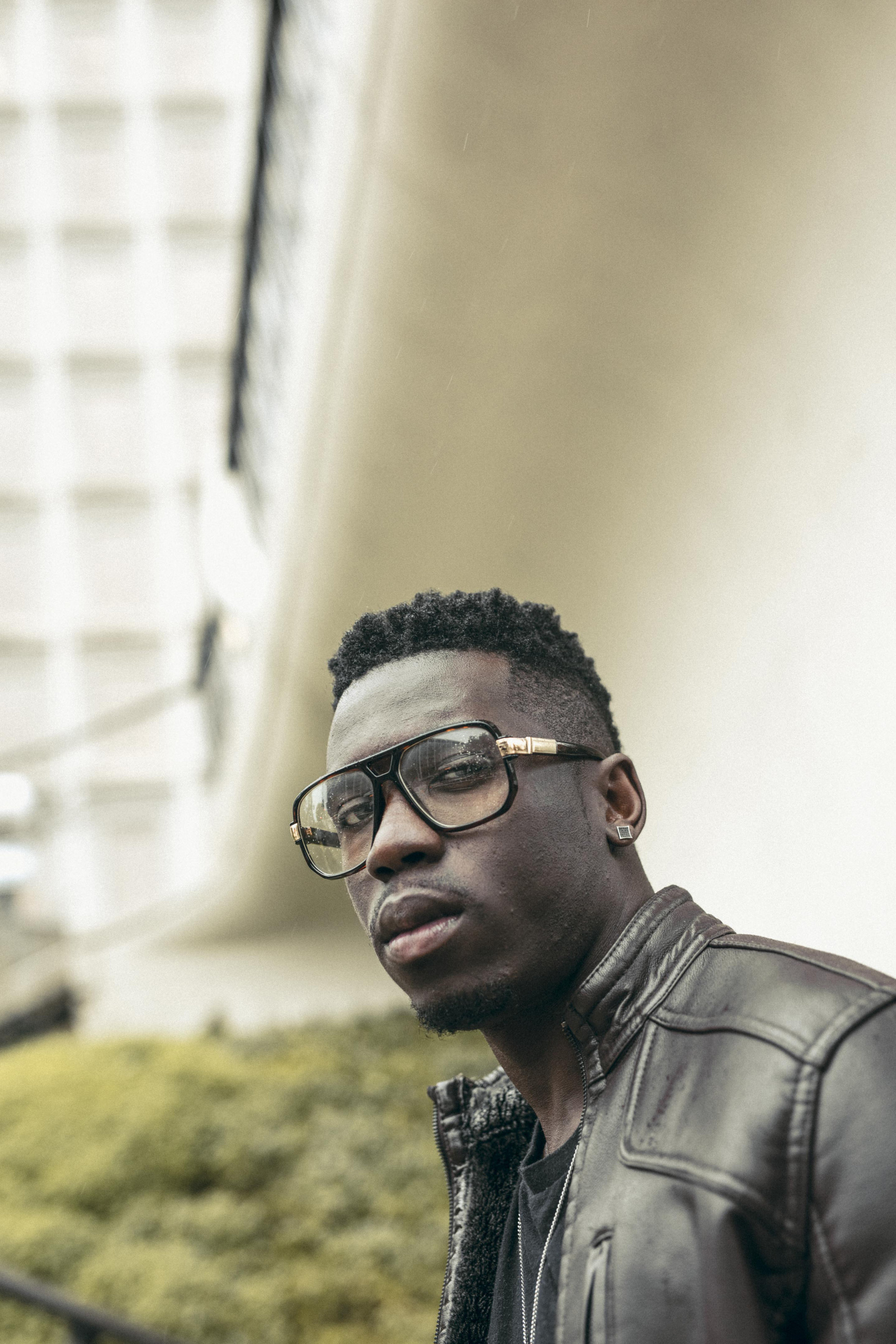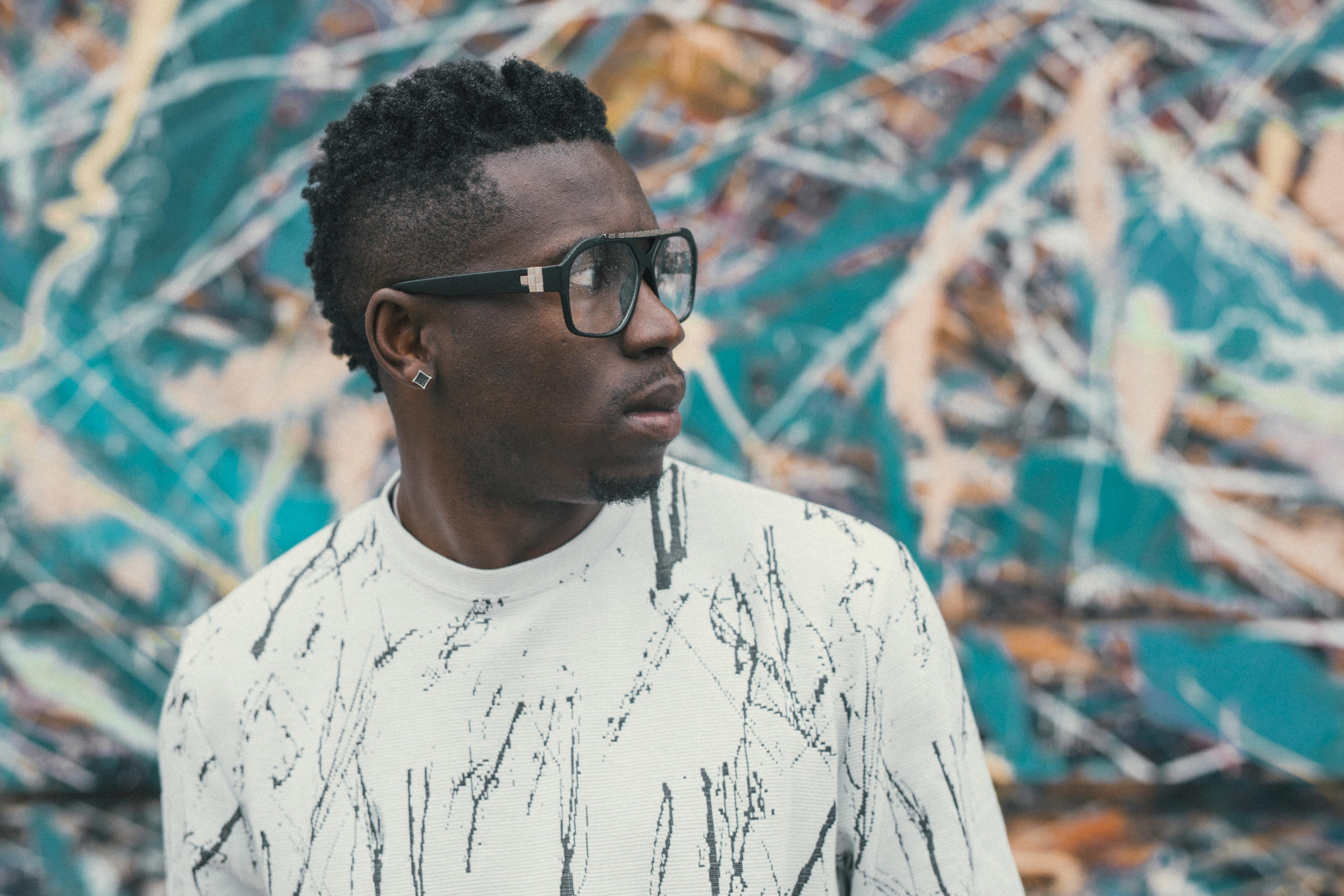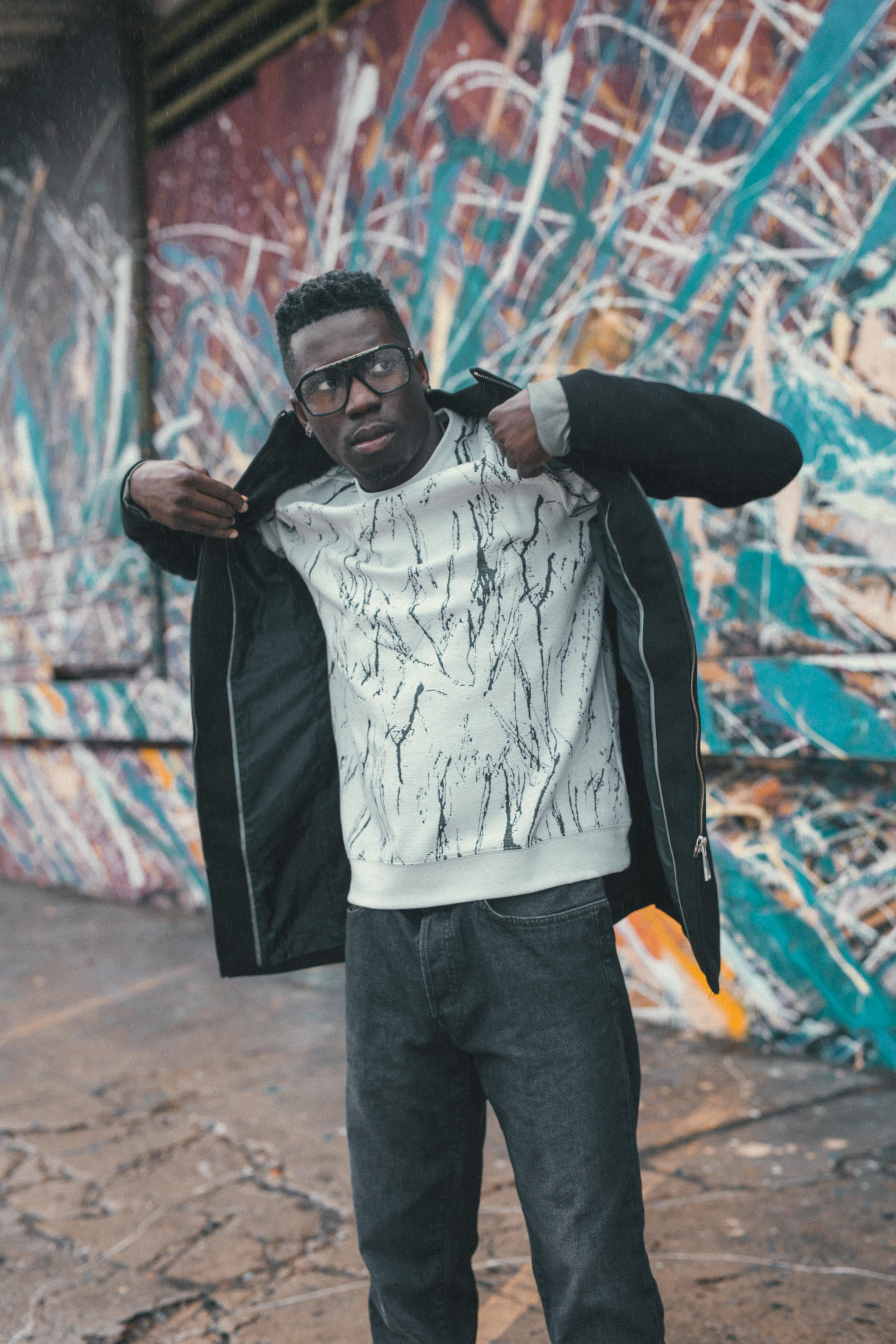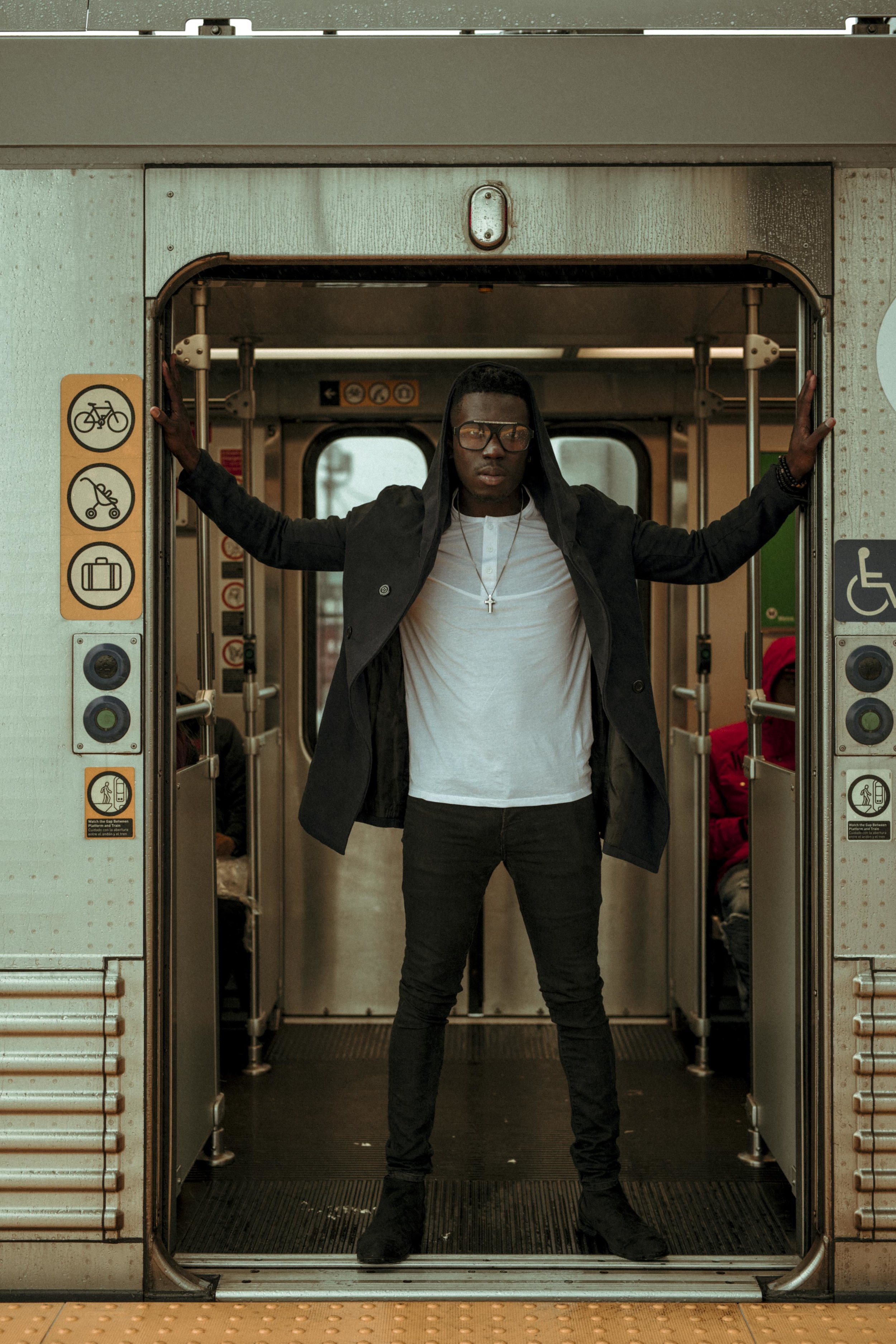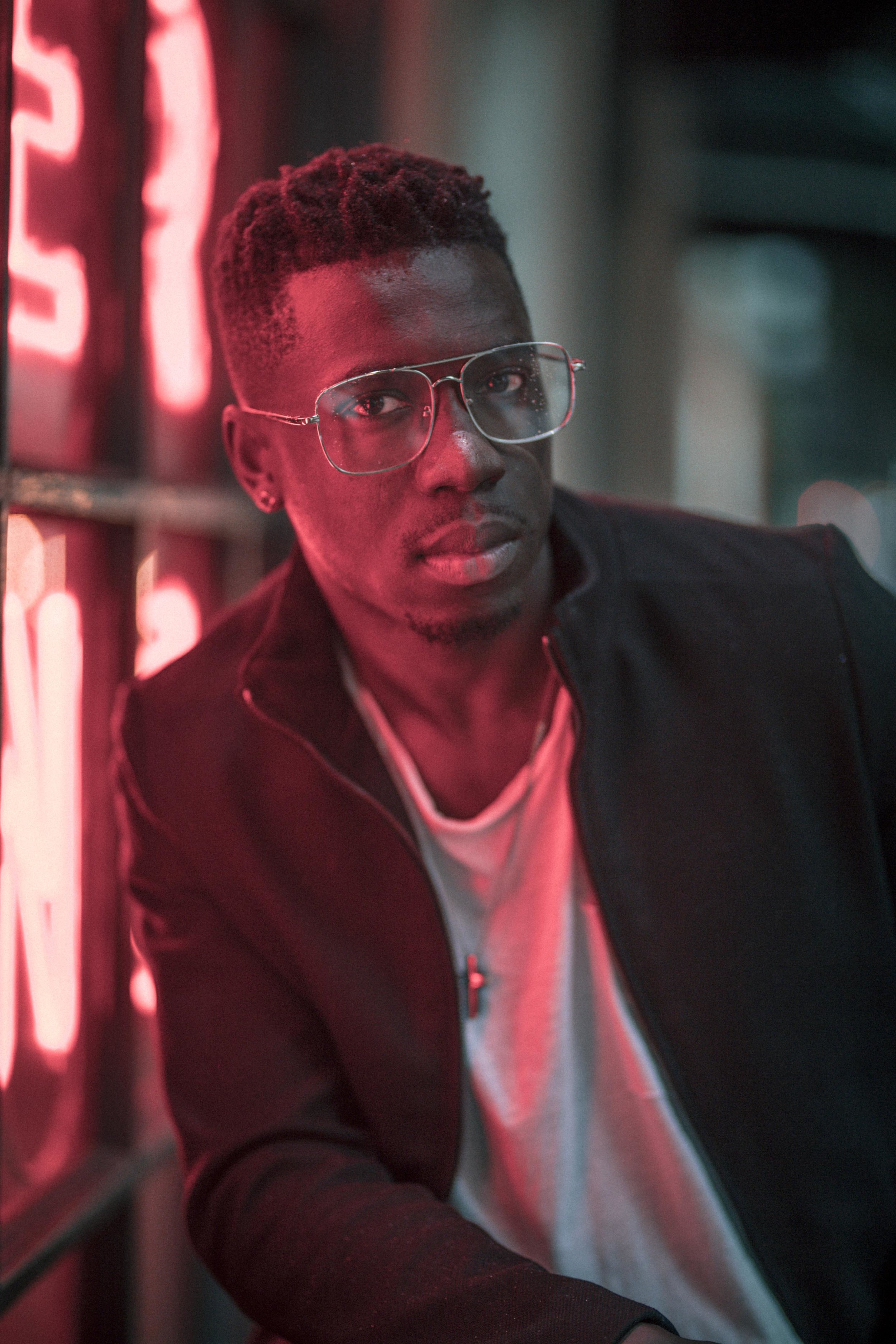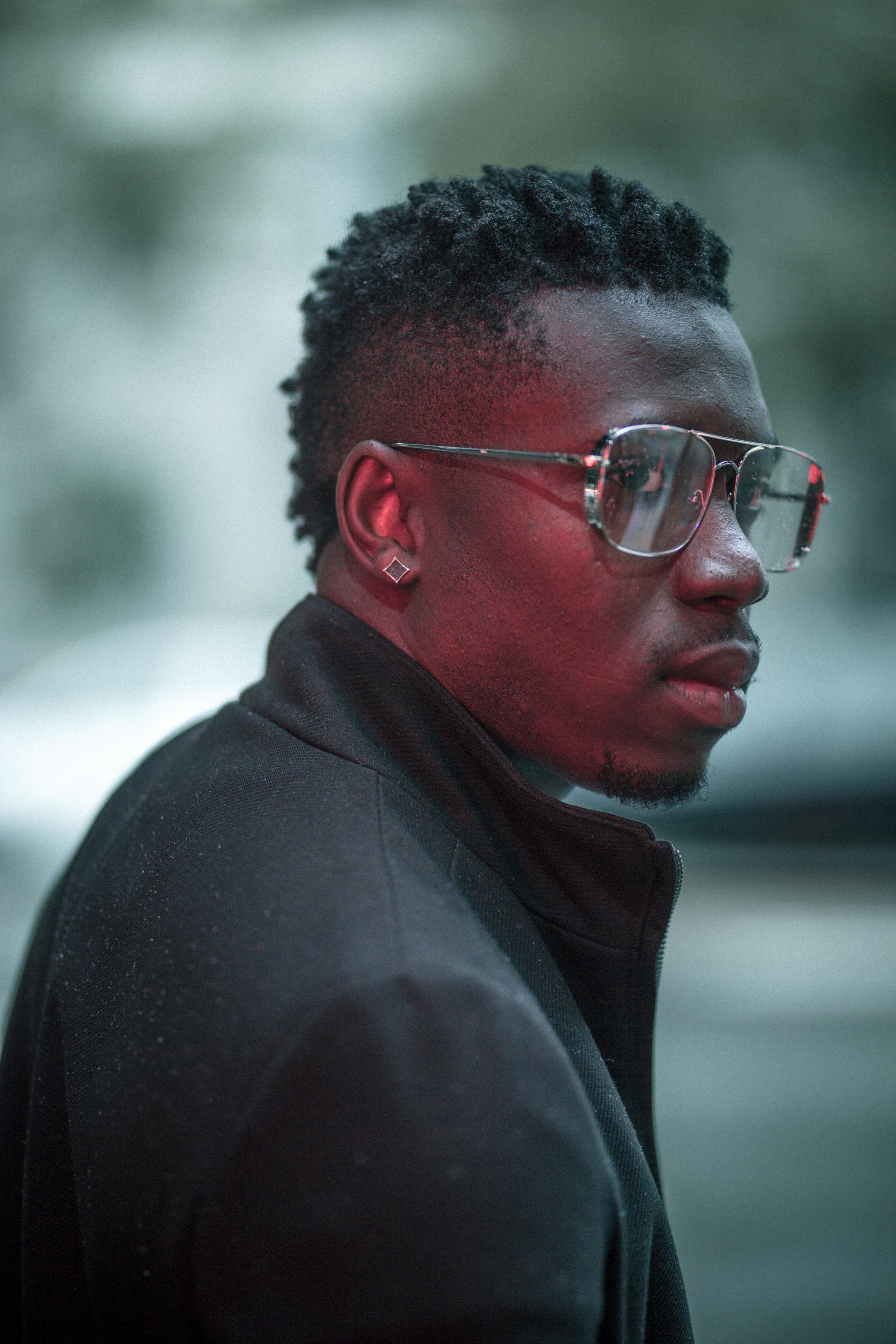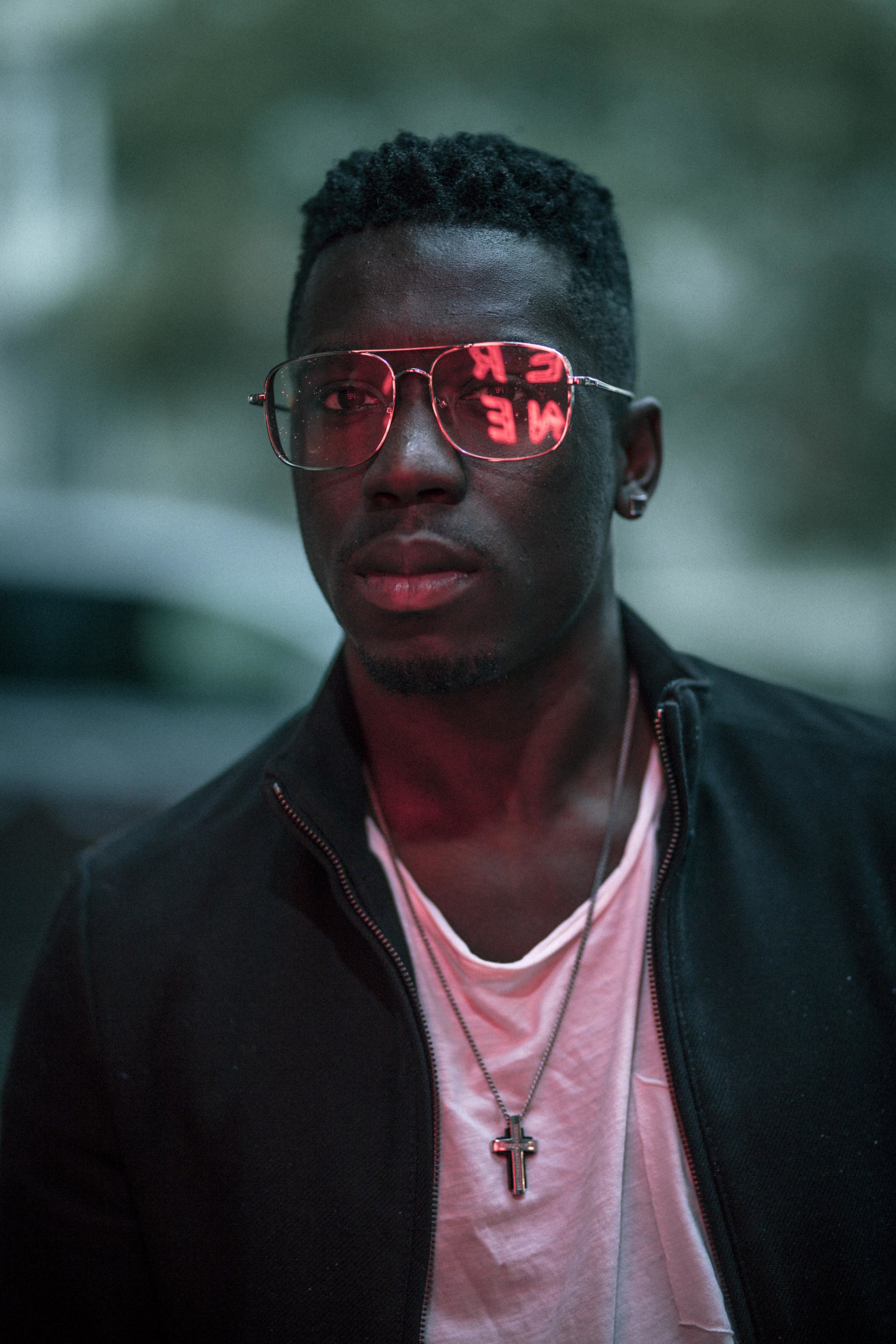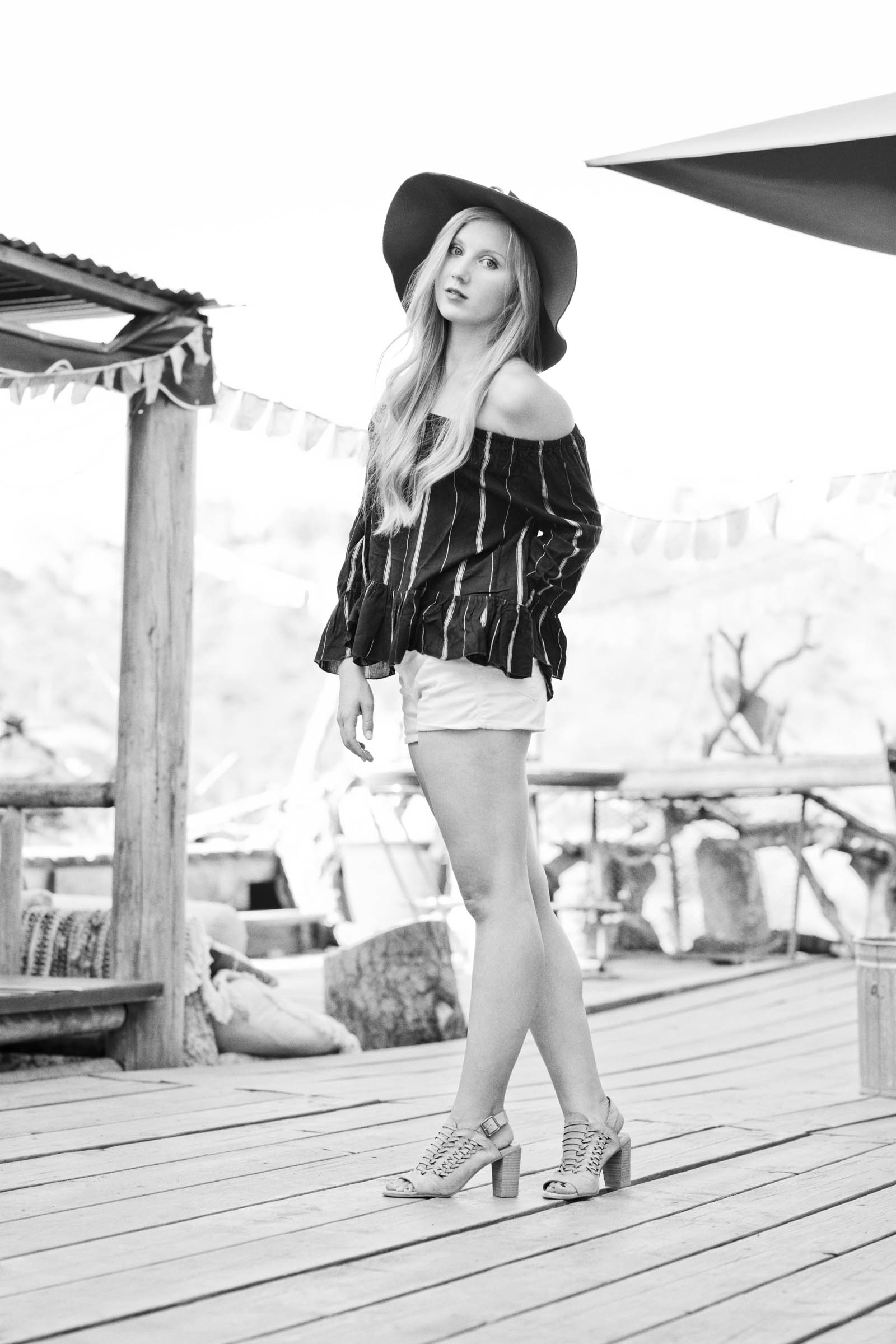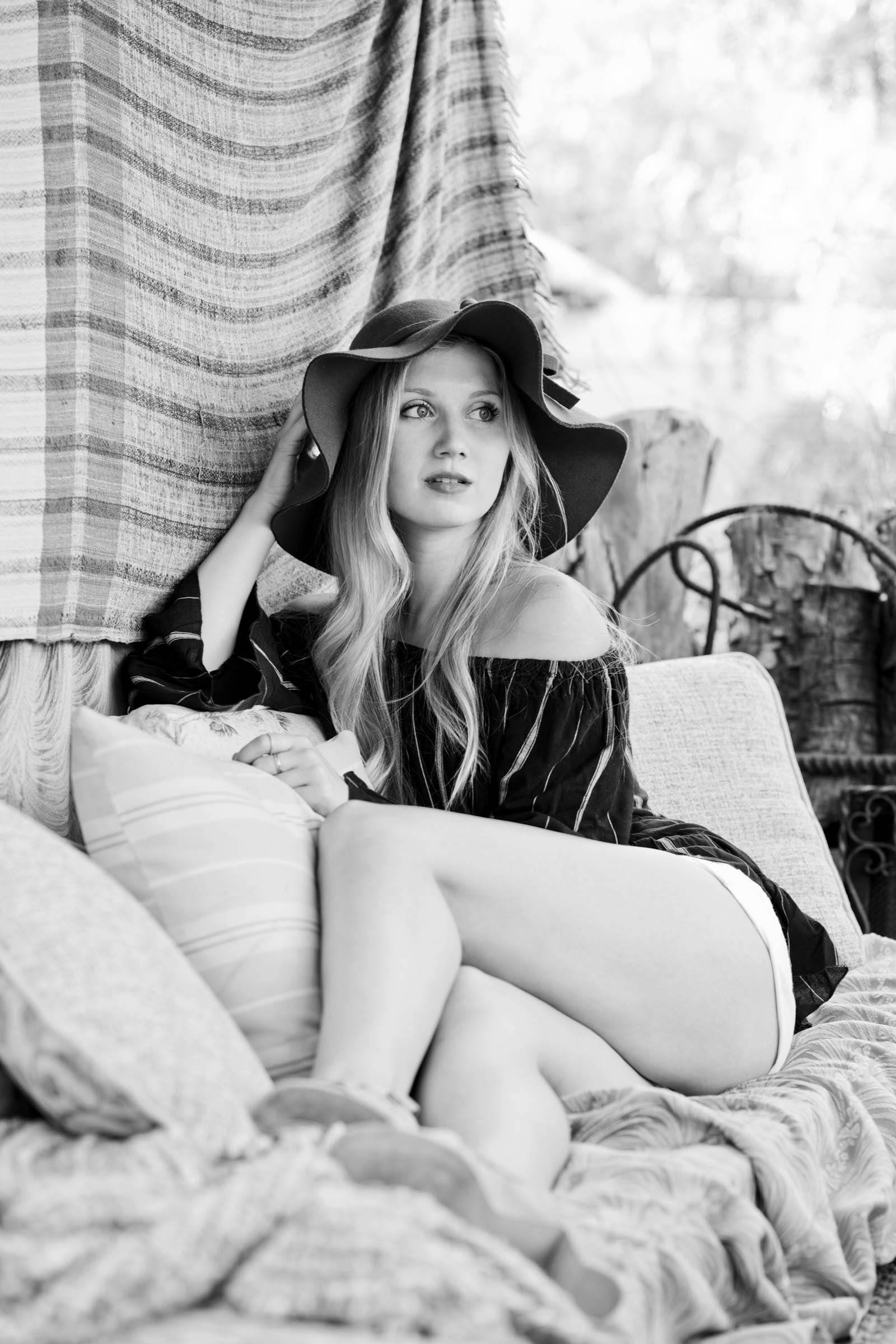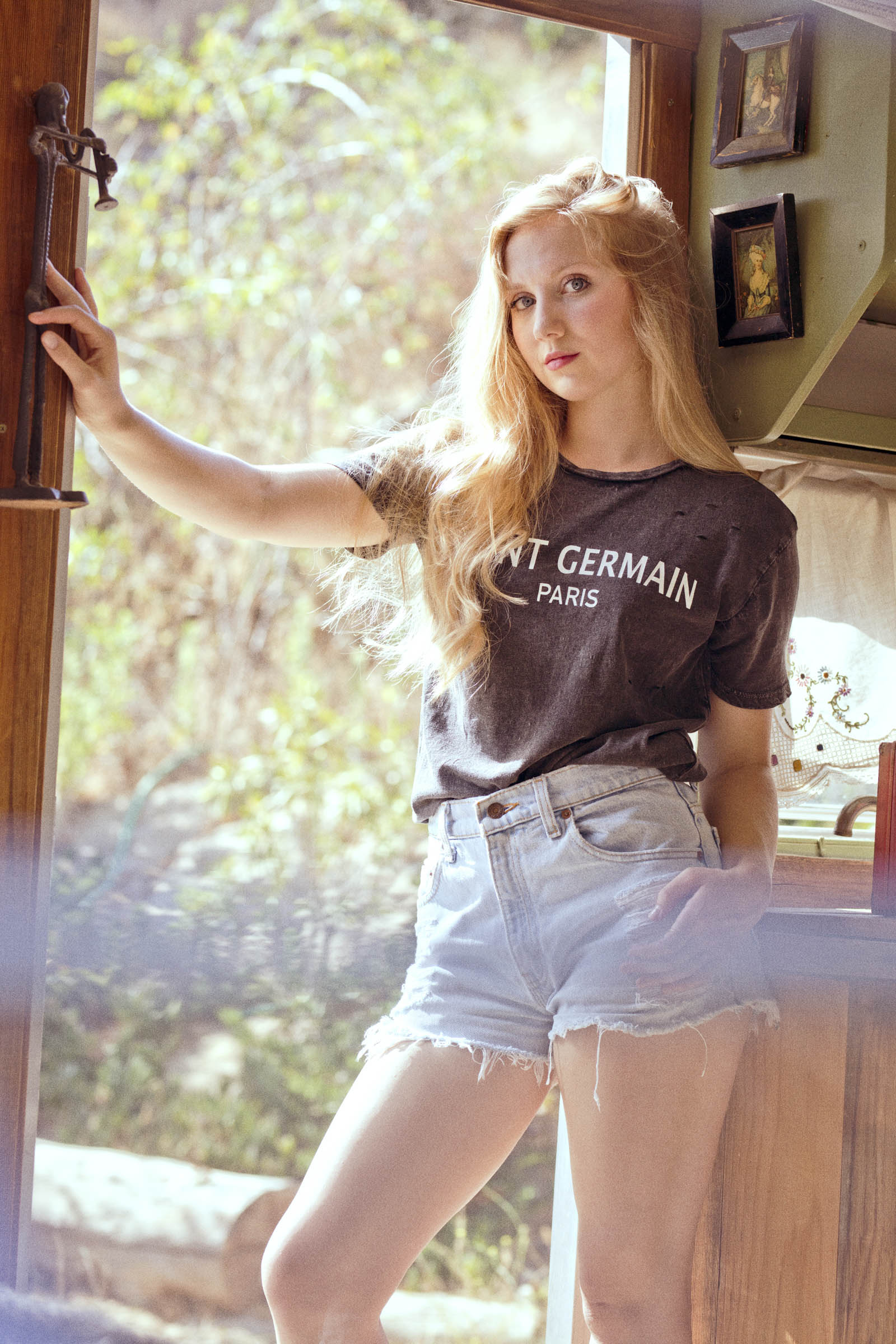DTLA Model Test Shoot
Rooftop test shoot in DTLA
Photoshoots on a rooftop will never be a cliche’. It does’t matter if you’re in Los Angeles or New York City, a rooftop will always be a dope spot to make photos. For this agency test shoot I photographed Laura on a roof top in DTLA. We were afforded access to the entire rooftop but we chose to stay within a certain section that fit the vibe and looks were shot.
One of the biggest cliche’s a photographer can make for a backdrop is train tracks. Unless you’re photographing someone for the Train/Rail Industry I’m sorry to say train tracks are over played. It is nearly impossible to make an original image on train tracks. Its all been done. Rooftops however, they are an evolving canvas. The rooftop that we photographed Laura on had a lot of different spaces and elements to work with. Change the looks, the time of day, or even how you make photos and the same spot can be transformative. In a future I post I will show a shoot from the same rooftop but with a slightly different view of the background and an entirely different vibe and style.
This test shoot with Laura was a ton of fun. Laura and I clicked right away and she was amazing to work with. My makeup artist Mel clicked with her as well. This type of connection is vital to the success of a shoot. Without establishing a good rapport, you’re going to find a shoot can be boring, lack communication, and just otherwise not be fun. A good test shoot should result in building a relationship, creating a connection with your models, creating awesome work, and leave you feeling accomplished. A great test shoot will produce an outcome that lands your images in their book and ensure the agency is happy.
Like I said, this shoot was a ton of fun. It was the type of shoot that created lifelong friendships.
Los Angeles: Fashion in the rain
This article is the first of 3 about my recent trip to Los Angeles. 3/13/19
I worked hard to layout a schedule in the weeks and days leading up to my arrival in L.A. I coordinated with models and my friend Rome, an R&B artist that I have photographed before. I have had images of Rome on my website since the first time we met and I photographed him. Its been a few years. While planning my trip I let him know I was going to be in town and we should shoot. He was eager. He was anxious. He was excited. He was looking for some updated work of himself and left all the ideas and creativity up to me. I built a mood board around him, his styles, and of course reflective of his talents and industry. I set the foundation for a great shoot and the last thing I needed were locations. I contemplated a studio. I looked at the options for renting and decided against it and to stick the the theme in the mood board, which was an urban, city vibe. Not that banal grungy urban cliche we’ve seen shot to death, pun intended. Not having a vast data base of locations previously scouted, I had to take some time to scout once I arrived. That was priority number one after checking into my Airbnb, get out, see, create, and document locations I was going to use.
For whatever reason I checked the weather 48 hours before I was flying out. It must be a force of habit when traveling to check the weather. Well, once I slid the screen open and pulled up, Dark Sky, I was met with gloom. Nearly an entire week of rain in the forecast. I dropped the phone into the cup holder with an echo that mimicked my now re-adjusted mood. What the F*** was I going to do. I had planned two big shoots outdoors and was hoping to film my entire week with outdoor shoots. I took a few hours to think of what I was going to do. I needed a back up plan for both outdoor shoots. One of the shoots, TBD, To Be Discussed, in the next post, will spot light a schedule change and the location. Well, if ever there was a wrench thrown at anyones plans, it was at mine and it was right then and there I knew I was going to have to flex some creative muscles and figure something out.
As I mentioned above, I thought for a hot second to rent a studio for Rome. That thought crossed my mind because some of the images I pulled were location/studio based. I ultimately decided against that because I wanted something location based. I wanted to shoot in LA, embrace LA, and get an LA vibe in our images. So the studio wasn’t something I was really pushing for. Rome had a date on his books and that wasn’t going to change. I wasn’t going to request a schedule change and disrupt his busy life so we could get something better. The problem was rain. The solution, make it work. If I was shooting a big production with a massive team and big dollars at stake, we wouldn’t be rescheduling unless hell itself was hailing stones down on us. Even then, I would still roll with it. With rain in the forecast and knowing it wasn’t likely to change, I set out to scout some locations that would be ideal. I decided to check out the arts district. Until then, I never visited that area. I have seen some youtubers shooting in that area so I figured I would check it out.
I found a gem. A spot that made me go, “WHOA this is going to work.” I wanted to stay very clear from any wall that was saturated with artwork and graffiti. Again, avoiding the banality of the urban landscape. But but but but, this wall spoke to me. Flashy. Vibrant. Ultra. Portra. The right amount of saturation that would yield something spectacular. I was like, this, this will work. I took a photo of the wall, pulled up GPS on my phone and got my location and made a screen shot. I would end up spending two hours doing this. I was happy with my choices and knew that I would have some great images to work with. I had enough locations and ideas that I could create enough images for Rome that he would be able to use them on a multitude of platforms. The next hurdle was styling the shoots. The stylist I was hoping to work with couldn’t get her schedule to sync up with ours. No worries. I got this. I did. I did just that. I sourced the looks myself and built a wardrobe based on his style and the mood board I curated. To be confident I had enough looks I made a stop at one more place and found a crew sweatshirt. When I saw it was like Indiana Jones seeing the holy grail. Gold light was shinning from the rack right to my eyes. The entire room went dark as the gold radiated out, calling me, begging me to photograph it. This shirt not only was going to make the shoot, it literally was artfully made just for my above mentioned location. I don’t know how or why, perhaps it was just the timing of things, but something aligned and I knew I was on to something. As amped as I was about this shirt and the location, Rome shared that same feeling when we arrived at the spot. Gold.
With the locations, some great looks pulled, all I needed was a clear day. That was asking for to much. Even though my cameras are weather resistant, I really didn’t want to shoot in the rain. The only ones that can’t work in the rain, my Sonys. I wasn’t concerned about the rain like that. I was concerned about shooting in the rain and getting soaked. I did bring a single waterproof jacket with me, but when the talent is getting soaked, thats a problem. Lets roll with it. Lets see what we get and what we can produce. Yolo, right? That is exactly what we did. We went with it.
Hasselblad 500CM: A Legendary Camera
"So I bought a Hasselblad 500CM and I am super excited. I actually bought it back in September and have been using it as often as I can. There are a few reasons as to why I bought such a camera, read on! "
Inspired
So I bought a Hasselblad 500CM and I am super excited. I actually bought it back in September and have been using it as often as I can. There are a few reasons as to why I bought such a camera, read on! .If you were a commercial photographer working between the late 50's and the early 2000's, you likely shot on a Hasselblad and had an awesome career. Chances are you know more about them than I do or will ever know about them. I am learning as much about them as I can because I have a goal. My goal is to use film on commercial shoots. You heard it here and now and I will say it again. I want to shoot fashion and portraits on film There are quite a few photographers that I have come across that are doing so. There are rumors of film not only staying a live, but photographers that are working hard to preserve the continuation of film. The whole "Film Is Not Dead" movement, it would seem, is doing a great job of keeping it alive.
Ive said it before and will continue to say it. I grew up during the wrong time period. Film was coming to a rapid end by the time I really discovered photography. Rather, photography was taught to me and it discovered me. Some amazing work was produced on film between the 30's and 2000's and being a photographer during those years, you weren't saturated in a market or industry like today where everyone has a camera in their hands. If you were shooting film, it wasn't about the mega pixels, it was about film speed, shutter speed, f-stops, light, composition, and most importantly, the story. It wasn't about how fast you could shoot something and post to Instagram. The process was slower and more methodical. Something I am working on achieving in my work.
Juliane, Brooklyn, New York City, September 2017, Kodak Portra 160
At the end of the summer I, once again, began thinking about a Hasselblad. I have never used one, owned one, or really had a chance to hold one. I used a 35mm Konica sir when I was in school. My first real camera, which was given to me by my aunt, and later a 35mm Nikon N80. I did shoot a lot of medium format film, but I used a Holga, a cheap plastic camera that I used to make a lot of artistic images. Since my business has been growing so well, I thought about how fun it would be to buy a Hasselblad and use it for the purpose of art. When I began Googling Hasselblad, it became very clear that I had the gear bug. I wanted one. I started looking at the prices and was a bit put off by a few of the online retailers that were reselling them. A few years ago you could get one for a steal. Today, not so much. I was joking on social media that hipsters who never used film were responsible for the costs being driven back up. Truth is, it might be a few factors, such as people like me, photographers who want to use something they never had the means to use, people that used to use them for work and want to play with them now, or people that just want to try using film, whether they are new to it or used to use film.
I couldn't walk away from the idea, even with the prices being north of what I wanted to pay. I began watching youtube videos about them, which only fueled the interest even more. Then I started finding photographers that are shooting fashion and portraits on film. In fact, there are a lot of people who shoot on film, including photographers who shoot film exculsively. Not everyone is a commercial photographer, but some are great photographers who happen to like the idea of film as much as the results of film. It was during my Youtube research that I discovered how easy it is to process color film at home. Really easy as I have discovered. My formal education in film photography. I spent a lot of hours in the darkroom, something I miss.
Why Film
Why not? Right? But no, for real. Film is film and film has its place in the world still. Over the last 10 years I have shot a bunch of film. I went through a period shooting Polaroid, the professional stuff that was discontinued like a year or so ago. When I was shooting it, it was stupid cheap. I was seeing packs on Amazon for less than $8.00. You could get bulk quantity, which brought the price down to about $5.75, the lowest I saw. Then, with no warning Fuji dropped a bomb and the prices went through the roof. Since then Ive used one pack and thats it.
Film has a look and feel, sometimes a grain at the higher ISO that has a texture that is to die for. Tri X 400, such a good film. I have been shooting a lot of Kodak Portra 160. It is a great film with nice tones. I will be experimenting with some Fuji film shortly as well as Kodak Portra 400. But in all seriousness, film produces something that digital does not, a tangible image that can be take right from the camera to the developing tanks to the film scanner and the pages of a magazine with almost no post processing with minimal to zero retouching, if that is your thing. Due to a computer upgrade this past January, I had to replace my film scanner when I bought this Hasselblad. I skimped and bought the mid range Epson 600. Its a good scanner, but it is no drum scanner. So again, the question, "why film?" To simply put it, each roll has 12 frames on it. That means you have 12 images to gain from 1 roll. In the age of digital, you can shoot 1,200 images in a heart beat and find the image you need. With film, you can not shoot on auto and make 1,200 images and just pick what speaks to you, you have to make the image through a strong, well lit composition in camera, and ensure that you have directed the image to be exactly what you want to see. If you are working on set and the art director wants to see something with motion, you'll need to ensure that you're on point with capturing motion quickly and effectively. It make take all 12 frames just to get that one image, but that is part of the process.
What will have been reinforced several times throughout this post is that I bought this camera to slow things down. I am in the process of developing my portfolio. I am shooting a Canon 5dS with a Sigma 85mm, using natural light as well as strobes to make the work I want to be shooting full time. I am integrating the Hasselblad and possibly other film cameras to be added, as I have a nice Nikon F4, another legend, and perhaps I will use a Helga on set...But I am using the process of shooting film and a Hasselblad to refine my abilities to direct models as well as the people I am shooting portraits of. I have been reading more and more articles about film used in both fashion and portraiture. 1 name comes to mind, a recognizable name, Platon. This dude is a legend in of himself, shooting some of thee most incredible people in the world and doing so on film. But a simple google search of photographers using film, or film and fashion, will bring up some impressive results.
See, the thing is, with the internet and the times we live in now, we can learn so much more, that much quicker. This alone is helping people to learn about film and bring about a strong use of film in various industries, such as fashion. For every portrait shoot I do, I will shoot a roll of film. For every model test that I produce, I will also be shooting film. This is a goal that I am passionate about. Will film make me a better photographer, no, it will make me a better director, which will make me a better photographer. If I go shoot a dramatic landscape with my Hasselblad, I will get a pretty picture. If I shooting film and directing a model to pose and emote everything I want to see and do so without hammering the shutter button, I will be gaining more experience with communicating and directing, which is something I am working hard at.
First Impressions
When I sat down I was excited. I was handed a Hasselblad 500CM by the older guy who sat across from the Starbucks table at Barns and Noble. I eagerly opened the view finder and moved the camera around and looked for something to focus on. I moved my hand slowly until the image came into focus. I was happy. I was excited. I was sold. I found the craigslist ad posted in a city 90 miles away. The guy said he posted it there because he thought that market would sell faster than ours. Funny I said, because "here we are and you're selling it in town."
In terms of a camera, a medium format system is far more complex than a 35mm camera set up. There are more components to the system. A 35mm camera has a body and a lens. You open the back and load your film. Some have lenses with auto focus where as there are others that are manual focus. A medium format camera system such as a Hasselblad have a body that takes a film back as well as a leaf lens which has the f-stops and shutter speeds in it, a lens that differs drastically from a 35mm sir lens, and the viewfinder, which can be changed out. The shutter is located in the lens, not the body such as a 35mm, which equates to that drastic difference. How the Hasselblad functions is vastly different as well. It takes a considerable amount of time to learn how to use the system, such as focusing and building the composition. If all you know is digital cameras and iPhones, expect a big learning curve if you plan to purchase a medium format camera. But for me, it wasn't about the glamour of using film, no, for me it is about how the camera functions, the process of focusing and composing, the process of setting an f-stop to work with a shutter speed on a leaf style lens. For me, it is a process of slowing down and thinking more. I want to be able to direct the shots, not let the shots be directed.
Lake Dunmore, Salisbury Vermont, Kodak Portra 160
Practice
Shoot. Process. Repeat. Film is funky and temperamental at times. It has a job, be exposed, record the image with the use of light, and be rendered in permanence through the use of a chemical process. It takes a considerable amount of mechanical skills to load film onto a reel in the dark. If you have never done so, it will take you a bit of time to be 100% fluent. When I was in school I might have ripped a roll of film or two trying to get it on a reel. Practice, practice, practice, I will keep saying it until you beyond confident and can get it done in seconds, not minutes.
Since I am shooting 120 film, the reel is wider to accommodate the width of the film. It takes a bit more effort to roll the film on to the reel smoothly. It does not go so easily when using a plastic reel. I have found that the natural curl the film has from sitting on the spool has caused the film to come to an abrupt halt when trying to load it. There are two little ball bearings on the left and right side of the guide entrance which are responsible for this. Super annoying. It took loading an unexposed roll of film in the light to figure that issue out. I am glad I did so, as now loading these plastic reels should go smoother and not take 10 minutes per roll. (Insert eye roll). The most frustrating part of this process now, is that I remember back to when I used to roll 120 film onto reels after shooting with the Holga cameras. Never did I have so much issue doing so. I feel part of the problem now is that I am putting to much pressure on myself to do so.
Robyn, Kodak Portra 160
Since I have been shooting so much color film, I have also run into the super technical dilemma of keeping the chemistry at the 102 temperature. What I have to do is run the chemistry under hot water, usually between 120-140 degrees for nearly 10 minutes before the chemistry gets to 102. By the time the developer, first step at only a whopping 3:30 (mins/secs), is hitting the film, the water temperature has dropped, which can cause the Blix, second step, to start to cool down. The Youtube video that I watched that showed how easy it was to process the film featured two guys filming in a kitchen and processing the film in basically a sink. They made keeping the temperature consistent, look easy. It is not. I am working to solve that issue. I am not sure if it is the sink itself or the hot water heater in the house... Maybe in the future I will post about it, but for now, I must deal.
Juliane, Brooklyn, New York City, September 2017, Kodak Portra 160
Lessons Learned
I have shot and processed about a dozen rolls of film. I have freaked up loading two rolls and accidentally exposed a roll of film while loading it on the reel. I can only imagine how many other people can relate. Back in the day commercial photographers would have assistants loading their cameras. The job was to get the film in the back and have other pre-loaded backs ready to swap on the the bodies when the 12th images was exposed on the roll. These assistants were the forefathers of today's digital techs and assistants.
There is a little piece of metal that slips into the film back, the dark slide. I have forgotten to put that back in while unrolling the film from the back. I was told, thank you Youtube photographers, NEVER to take the back off while the slide is out. That is a mistake I have not made and will not make. I have seen a few frames that have this light leak that comes from the same direction. All signs point to the dark slide causing light to leak when I insert it back into the film back. If I am going to shoot the entire roll of film in one shoot, I will keep the slide out. If I need to stop shooting and put the camera away, I am forced to replace the slide in its place.
Shoot More, Fail more, learn more, shoot more, Succeed
To alleviate the headaches of improper film loading in the camera, the processing reel, and to ensure things run smoothly and I have a 110% grasp on this new system, I am going to get some black and white chemistry and black and white film and shoot a ton. It is easier to process black and white, as you don't need to have the chemistry at a consistent 102 degrees. Plus I will reserve working in color on film for the commercial work that I want to do with the camera. It is incredibly important that I make using this camera a success. With the dollar amount already invested into the camera and the time thus far, I will not stop until I have taken this to the level I want to.
We are expected to fail. Failure is part of the creative process. When I think back about my business, the images I have made, the projects I have started and either never completed or walked away from, I don't see a lot of failure. I do however see a lot of attempts, a lot of learning, and a lot of taking what I have learned and apply to current and future projects. I try not to think about failures and what hasn't worked, because there is so much that I want to work, that I do not want to be brought down by any one thing. With this camera system, I want the process to be successful, not for the financial gain, but because, like I mentioned above, one of the main reasons for this camera is to slow things down and have a better directorial approach to my work. By my measures, I would say I am 80% successful.
Juliane, Brooklyn, New York City, September 2017, Kodak Portra 160
Model Test: Jessa Part III
If you were to ask me before July, "what do you think of California?" My response would be simple. "I dunno. Ive never been. Ive heard good things." Driving up the coast in a convertible, heading into the sunset up into the hills of Malibu, the sun setting in front of me casting an orange glow on the pavement teasing me, saying "keep driving life will get better every mile you search ahead." To contrast, the north east is nothing like California. Boston is fun. New York City is, well, New York City. You love it or you hate it. I happen to love New York City. When you compare LA to NYC, you have two completely different types of cities, lifestyles, and of course, different looks. NYC has a jungle of concrete, Steele and glass. You can be on a rooftop in Long Island City and the view is nearly the same as something you'd see in lower Manhattan.
Brooklyn seen from the rooftop of The Boro Hotel in Long Island City, NYC
What I have seen in LA seems to be different. Very Different. The light is different, the skyline is different. Turn around and the view changes. Turn around again, the view changes. Hop to another roof top, the view changes, the mood changes, the looks change. The photo of me, below, is from the roof of a building in DTLA. That is from a studio shoot the day before the test shoot with Jessa. That shoot will be discussed following the posts of Jessa.
Roof top from Apex Studios in the Fashion District of DTLA, July.
View of DTLA from roof top of Apex Studios.
I bring all of this up, show these images and comparisons for 1 reason, LA is different. Here is why. In the course of 24 hours you can be on the beach, the most quintessential view of Souther California shooting life style fashion, the next day you could be in a studio shooting a look book or some ecommerece. The day after that you could be in the hills shooting an editorial or on a Hollywood set shooting portraits. For me, from my perspective, the vast differences in locations that are seemingly nestled together, LA has a lot more to work with.
My test shoot with Jessa in Topanga is a stellar example of how flexible the area can be. Turn the corner and there is an area ready to be use for any number of shoots. Turn the corner and drive down the road and there is yet another location ready for a shoot. I found Topanga to be especially inspiring. As quite and private as the area can be, I found it to be a hidden gem of sorts. If I was to be commissioned for an editorial to be shot in California, I would turn to Topanga before others areas. I would do so because I enjoyed the area and would like to use the elements that I saw in a shoot. Granted there are countless others spots I saw and have yet to see in the LA area, and other points north and south, but I know that I would like to shoot again in Topanga.
I said it before and I will say it again, the location was like a film set. I knew when I saw the Airbnb listing I just needed to rent the space. I moved a few pillows and made it a bit more comfortable, but other than that, I shot with the space as it was because it was that well set. As you can see by now, this being the 3rd post with Jessa, there really was a lot to work with.
Model Test: Jessa Part II
As mentioned in the previous post, my gear for this test with Jessa was minimal. A camera with one lens, a model and a photographer in an awesome location. Check out the quick video of the location. Nothing super special. Its not even a real behind the scenes video. It was more of less a few shots on my iPhone to show the space.
With the minimal gear that I had, I was limited to using just natural light. Even if I had brought a set of lights with me or a simple reflector, I wouldn't have wanted to set them up given the light that I had available. When I first arrived at the location I was awestruck. I have never been in a desert, nor have I ever been in the desert hills of California. The late day light was playing off the sand, creating a glow. Two parts of the property that I rented had airstream trailers, which acted as giant light modifiers. I didnt need a single light or reflector so long as I had the sand from across the valley and the light bouncing off the trailers. You'll see in the following posts how the light bounced through the environment and gave me a lot to work with. I am very pleased with the images we made.
I know it seems a bit odd to have so many posts for one test shoot. Surely I could simply reduce the number of posts and just do one post with 1 image from each look, but wheres the fun in that? Plus, this is away of generating more content and sharing more images. I am going to be revamping the site over the next two weeks to include all new work, both of Jessa and the other work I produced in Cali, so the more content I generate on the blog, the more visibility. Enjoy!
Goals: Career Path
They say the simple act of writing something down is the first step towards achieving that goal, task, or desire. At the very beginning of 2016 I put a glass dry erase board in my home office. I took a step back and thought about what I wanted, all the goals I wanted to achieve that year. I am not a New Years resolution type of person, but setting goals is something to work towards and helps build upon the success already achieved. With multiple colors of dry erase markers I graffiti-ed those goals onto the glass in hopes that I would see everything to completion over the coming year. There are pivotal moments in 2016 where I thought my abilities to complete my goals were not just sidelined, but benched for the entire year.
Its very difficult to take an idea, usually with minimal resources, and make it successful. An idea is just that, an idea. It doesn't become something tangible unless effort is put forth. For some people, effort comes with ease when they have the proper resources to take an idea from inception to a more concrete tangible form of success. When beginning new projects or making career moves it require a certain level of tenacity and resilience. You have to be as strong as the idea is in order to see it through. You have to believe in your idea and believe in your ability to see it happen. Starting and stopping a project is not the same as having a project fail. Failure is major contributor to the success of future projects. Without failures, there is no opportunity to learn, grow, create new ideas and projects. While reading a friends blog recently, I came to the realization that I hade quite a few failures from the end of 2015 into 2016. I didn't see them as failures at the time, because I kept on working, trying things, working, creating ideas, and working. When we refuse to continue to work we are saying two things, I give up and I can't. Can't means you wont. Can't is a form of accepting failure. Accepting failure can be broken down into two categories, the "I give ups" and the "I can and will make this work," attitude. Giving up means you're hanging your head low and walking away defeated. In contrast, I can and will make this work attitude will allow you to reposition yourself and pivot your ideas and resources in such a way that you'll make things work. That is the hardest thing to do, reposition yourself to become successful. It is easy to walk away and forget. It's harder to refocus, restructure, and reprioritize your goals. Outcomes change by other influencers, but if you stay determined, you will be successful.
Madison of Red Model Management, New York City
This past December I cleaned off my glass board. I wiped it down and removed every mark I made back in January. Each line that I cleared away was like a light bulb going off. Everything I wanted to accomplish, I did. I had completed every goal I had written down. Holy shit. I know, right? I was impressed and proud of my hard work. See, the thing is, I am a note taker. I have yellow post it notes as reminders everywhere. As a busy creative professional, my mind is working on 3 different things at once. Post it notes are my to-do list, reminders, and general notes, outside of my iPhone. I keep short term goals written on them while the larger goals stay written on the board. I do not look at those goals daily. I do not want to be overly stressed out to complete them, which sounds a bit moronic to say, but it really isn't. My days range from back to back to shoots to days of editing, meetings, planning shoots. If I was to be focused on the list I created, I won't be focused on the work I need to do, which usually shapes how well a goal will be completed. The goals themselves, they are either physical and tangible objects or they are things if desire, such as future work, travel, various components of projects or entire projects themselves. That is not to say that I write them down and walk away and don't look at them for 12 months, I do. I just do not make a daily habit of checking the board. While writing down ideas and goals is a simple mechanism to ensure their success, there are obvious things that need to occur. The most obvious, write them down and continuously work to be successful. For me, I work to produce to work. My work is a reflection of who I am and enables me to be successful, which helps me build on the list of goals I make.
To be successful, you need to be a leader. I'm not taking about a President, a CEO of a Fortune 500 company, or the class president. No. You need to be your own leader and guide yourself to the right path of success. There is no guidebook on how to be an entrepreneur. It does and simply can not exist. What works for company A will and might not work for company B. Parallel to that, what works for me as a photographer might not work for someone who is a graphic designer.
Brynn of Red Model Management, New York City
Laslty, you can not force success. You can not force your ideas to happen or to just snap your fingers and your goals are met. If you can do that, if you have that much resource, which most people do not and will not, congrats on being a .5%-er. Think about this: if you focus to intently on one thing, you're bound to neglect something else. Negelecting anything is to reject everything. Ideas, especially in the creative world are stimulated when we work. Placing to much focus on a goal is a wall building device that shuts out influence and inspiration from other forms of work and ideas. This type of practice is a means of rejecting the collaboration of a multitude of other resources, which can likely assist in the completion of any goals.
Focus on creating a list of goals and ideas. Work. Work hard and often. Keep your goals in mind and check in often. Work on your list and on bulding the resources and network you need to make your goals happen. Sometimes we need the support of a community or a few other creatives to make our goals come true. Keep working. Fail. Realize that you have failed and celebrate it. Failing means you've tried, attempted, came close, or will come close to makeing your goals a reality. Get a board and write down your goals. It can be a simple piece of paper shoved in your wallet or it can be an entire wall in your office, basement, home, or wherever else you want to store your goals and ideas. Don't give up and keep failing.
What I failed to do, failed at doing, or failed trying to do is irrelevant. What matters though, is that I realized that I failed and am not deterred from my goals. If I was, if I do, take no pity on me, for I will have become a quitter. Quitters don't share success or inspiration with you, they complain and whine about their failures because they are stuck on them. No one wants to work with someone who constantly fails and complains about it. The difference between healthy failing and the quitters mindset, they don't want to be successful through hard work, they want instant success given to them. I haven't found the Success Store yet or the page on Amazon that sells success.. No one is going to just give you anything. You have to earn it, work for it, desire it till it hurts.
Here are a few of my goals for this year:
- Increase revenue for my businesses.
- Scale my business.
- Reduce expenses.
- Retain more profits while reducing expenses.
- Shoot 5 ad campaigns.
- Network with Creative Directors, Art Directors, Photo Editors.
- Travel more.
- Travel for work.
- Plant roots in New York City for work.
- Get published.
- Learn another language (French and Polish are on my list.)
Go be successful. Go write down your goals.
The above featured photographs are from a portfolio building shoot that I had at the Boro Hotel in New York City back in January.


